NFSI 2024 Operations Summary - Ramping Up Activity
As we turn the page into 2025, we'd like to take a (relatively) quick look back at what we accomplished in 2024. To say we've had a busy year would be an understatement.
NFSI staff participated in 6 cruises between May 2024 and early January 2025, for a total of 57 days at sea, 53 instruments recovered, 82 instruments deployed, in addition to all the behind-the-scenes work required to make field work happen. We also arranged recovery and return of 3 instruments which surfaced unexpectedly outside of cruise times, and received and tested the last of the 121 Aquarius BOBS to complete the instrument pool. Let's dive into it all..
January - Expanding Our Capabilities
Shortly after we returned from our holiday break, we learned that Professor Vittorio Maselli of the Earth & Environmental Sciences department would be leaving Dalhousie for an opportunity in his native Italy. As a fellow EES technical group, we were lucky enough to inherit much of Vittorio's marine equipment, including a portable Kongsberg EM2040 multibeam system and a sub-bottom profiler, which had been used by the Marine Geology and Sedimentology (MARGINS) lab. We will be offering this equipment for use in future research projects.
February - Debugging
As mentioned in our 2023 update, one instrument which surfaced unexpectedly on the West Coast was recovered in late November 2023. At the end of January, this instrument was sent back to Halifax. Over the course of 2 days in early February, NFSI staff and Güralp engineers worked together analyzing the instrument and the recovered data to identify what had made it surface.
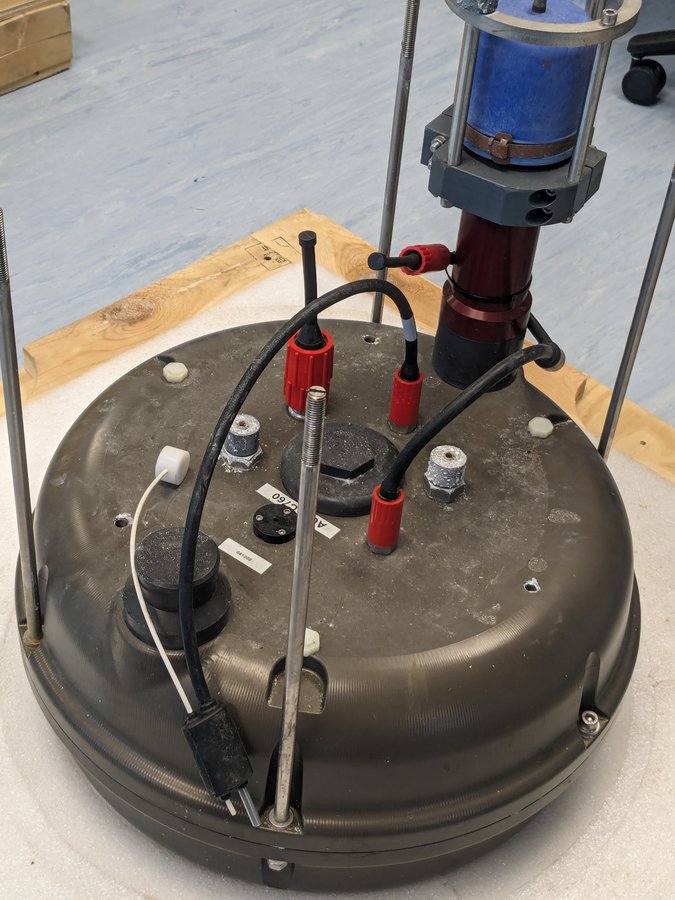
AQU-C760 pressure case in the NFSI lab after recovery. Photo provided by John Thibodeau.
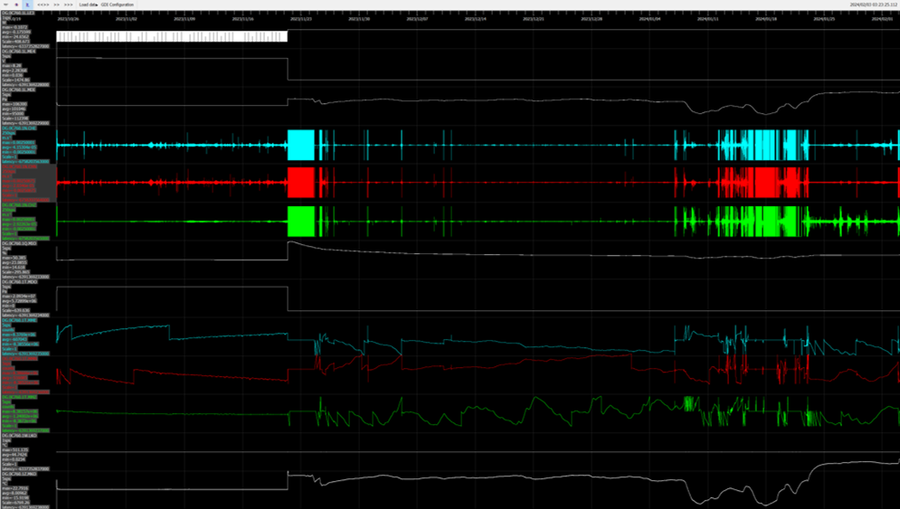
All data recorded by AQU-C760 (2S.L129), up to its arrival in the NFSI lab (including after surfacing and recovery). White traces are auxiliary channels. The top set of coloured traces is the seismometer components.
The recorded data were successfully recovered through the external data connector before opening the pressure case. The humidity sensor showed evidence of water ingress shortly before the release time. Disassembling the pressure case showed clear evidence of water ingress, with significant corrosion on parts of the circuit boards inside. Despite extensive inspection of the pressure case lid and all penetrating connectors, we could not pinpoint the entry point of the water.
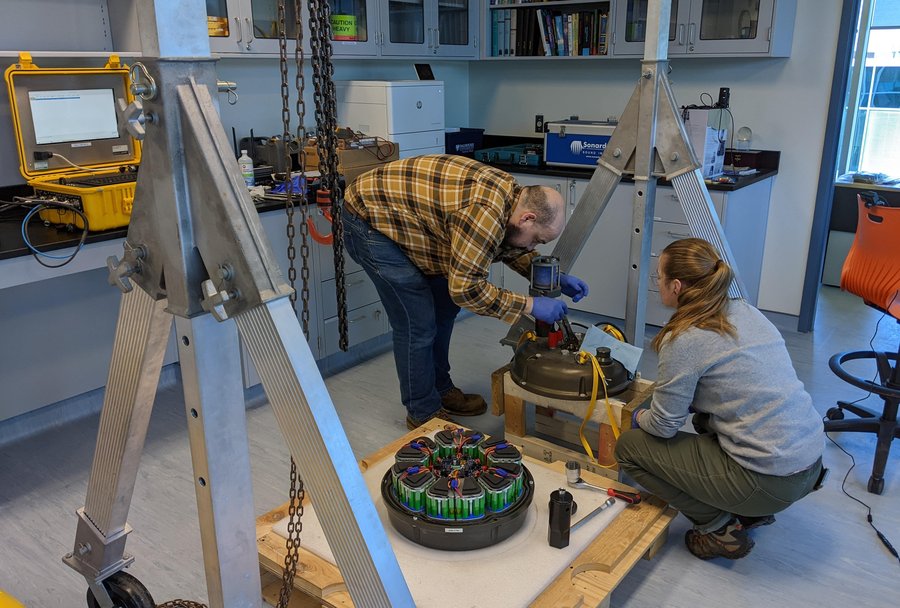
John and Katie disassembling the pressure case. The webcam at right allowed Güralp engineers to observe remotely from the UK. Photo provided by Graeme Cairns.
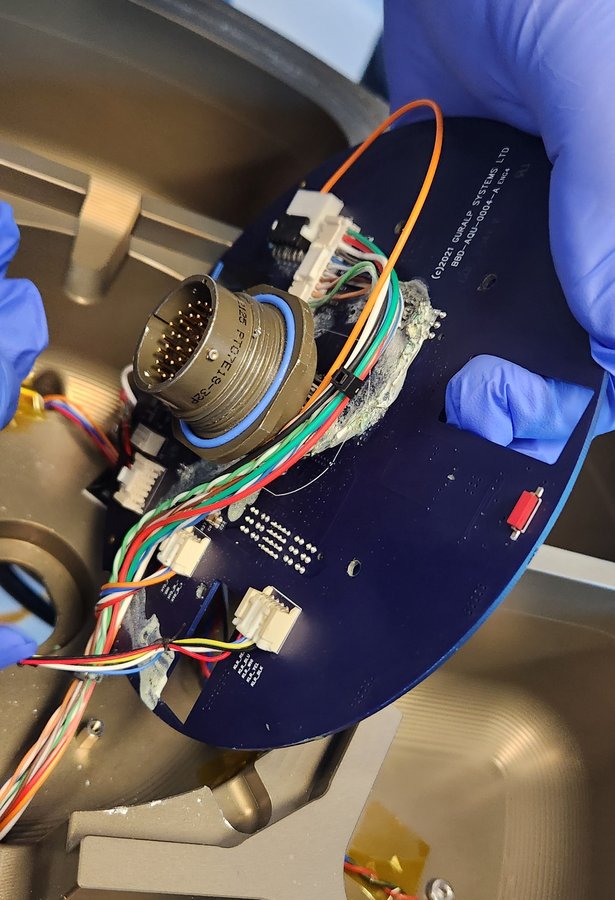
Significant corrosion is observed under the wires which lay on the lid interface board. Photo provided by Katie Bosman.
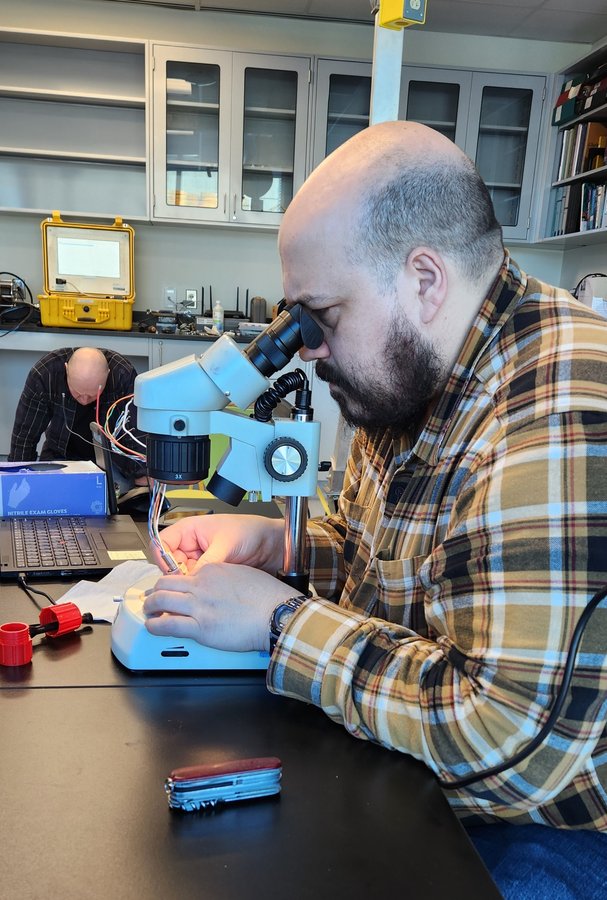
John examining the ethernet connector under a microscope. Photo provided by Katie Bosman.
On a positive note, the OBS recorded for 4 weeks on the seafloor before releasing. These data were provided to NRCan collaborators for integration with their existing land network, and will be included in the PACSAFE dataset (network 2S). Many local earthquakes were recorded while the instrument was at the seabed, and initial results suggest a very rich dataset for the full PACSAFE Leg 1 array, which should contribute significantly to ongoing research on the West Coast.
April - Gearing Up
We spent March and April preparing for the upcoming field season. With at least 3 planned field operations within a 3 month period, and the potential for more into the fall, the logistics of moving auxiliary equipment between voyages needed to be carefully planned to ensure everything got where it was needed in a timely manner. At the beginning of April, NFSI staff also participated in Marine First Aid training along with other Dalhousie field staff.
On April 5th, an instrument deployed in the Lower St Lawrence Seaway (deployment September 2023) surfaced unexpectedly. A local fisherman was lined up to recover the instrument when it suddenly lost satellite communication in the middle of the shipping channel near Matane, QC, on April 6th. We did not receive any further Iridium messages from the instrument. More on this one later..
In support of an ongoing research project near the Endeavour Hydrothermal Field, the marine geoscience team at Ocean Networks Canada (ONC) in Victoria, BC, arranged to rent 5 of NFSI's OBS to augment their existing network. The OBS and auxiliary equipment needed to deploy them were shipped to BC in April as part of our logistic push. Since there was no vessel space for NFSI staff to participate in the deployment cruise for this project, we provided training for ONC's field engineers in their Sidney office at the end of April, which was also attended by some NRCan collaborators from the PACSAFE project.

Loading equipment to be shipped to Victoria at COVE in lovely Halifax spring weather. Photo provided by Katie Bosman.
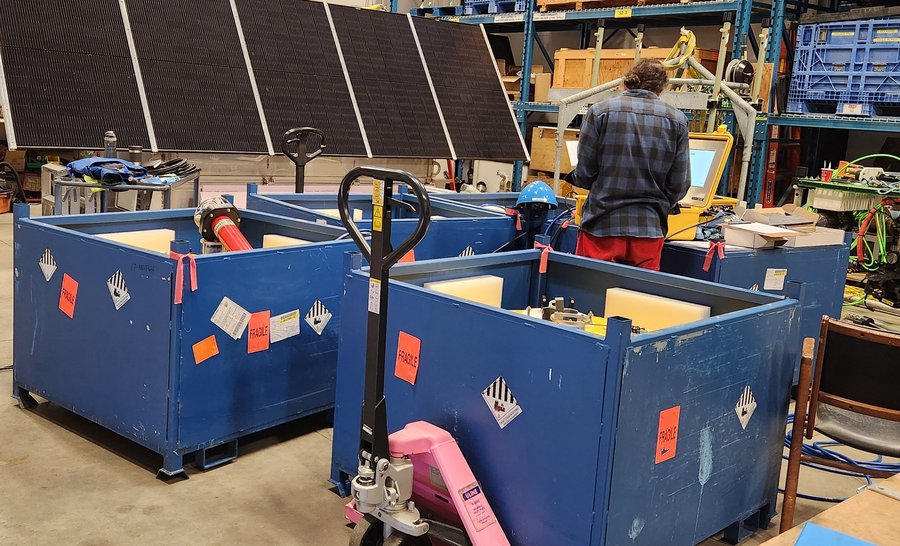
Hands-on training with ONC field staff for Aquarius deployment and recovery operations. Photo provided by Katie Bosman.
On the equipment front, the final shipment of new Aquarius OBS was received from Güralp at the end of April, bringing our total number of instruments to the planned 121 (minus a few lost so far in our first deployments).
May - Easing Into The Rhythm
Lower St. Lawrence Seaway Year 1 Recovery
Our first field operation of the year was the recovery of 7 OBS deployed in the Lower St Lawrence Seaway in September 2023. The Island Venture 1 out of New Harbour, NS, transited up to Matane, QC, for the operation. The weather was good, and we were able to recover all 7 instruments over 2 days of operations on May 8th and 9th.
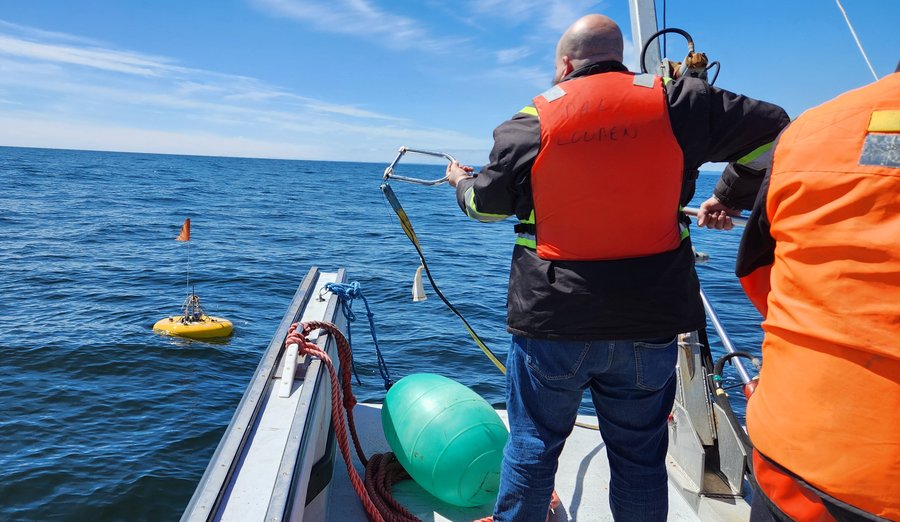
John preparing to use the Happy Hooker to catch a floating OBS at recovery. Photo provided by Katie Bosman.
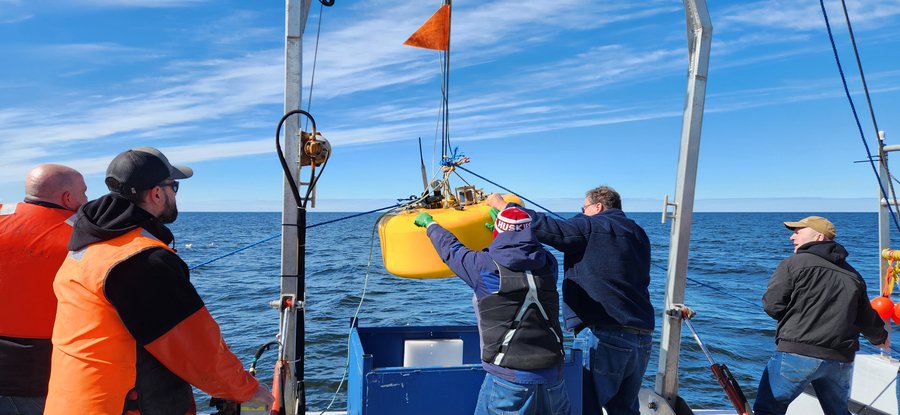
Crew of Island Venture and NFSI staff recovering an OBS using the stern A-frame. Photo provided by Katie Bosman.
The water depth at the St. Lawrence deployment sites is around 300m, making it our shallowest deployment so far. We found plenty of evidence of biological activity at the seabed, with various organisms attached to the instruments when they came out of the water. Being an estuary environment, there is also a higher sediment load in the water than we typically find offshore. All of the instruments were covered in a thin layer of mud, but were otherwise in good shape.
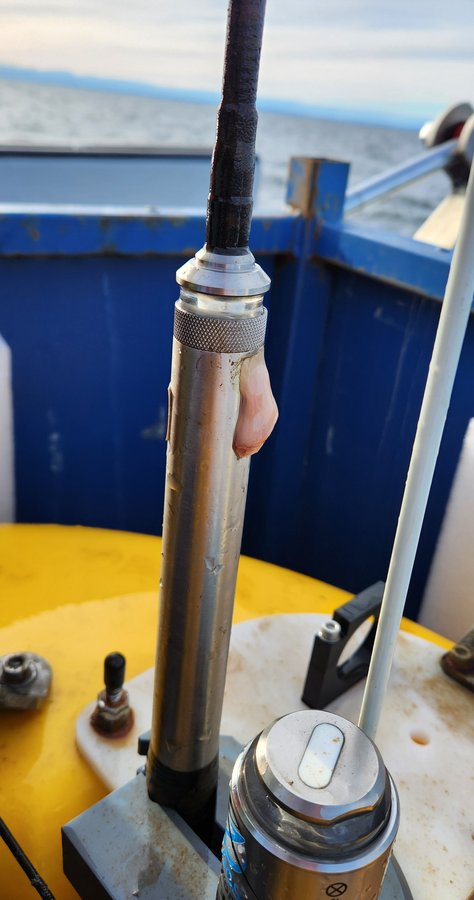
Slug attached to side of XMB-11k radio beacon. Photo provided by Katie Bosman.
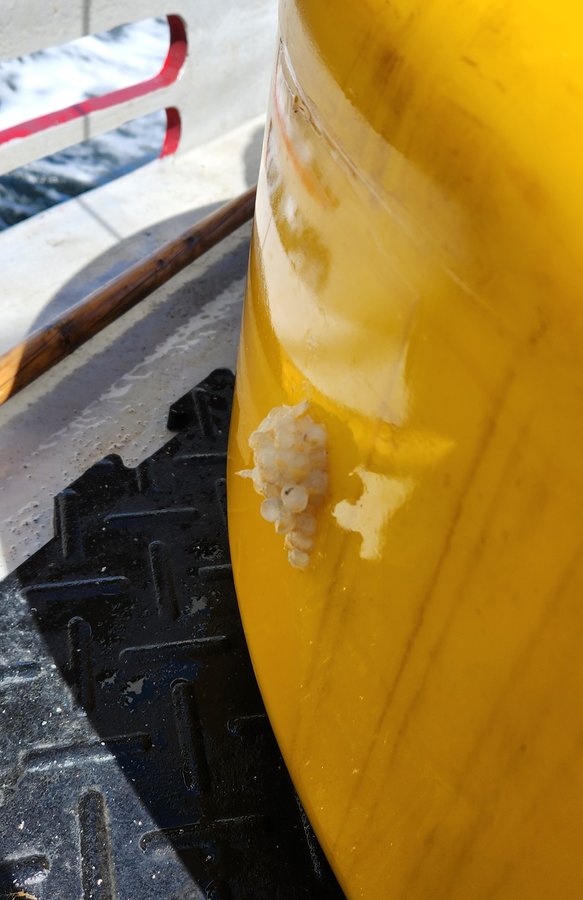
Cluster of fish eggs attached to side of OBS buoyancy. Photo provided by Katie Bosman.
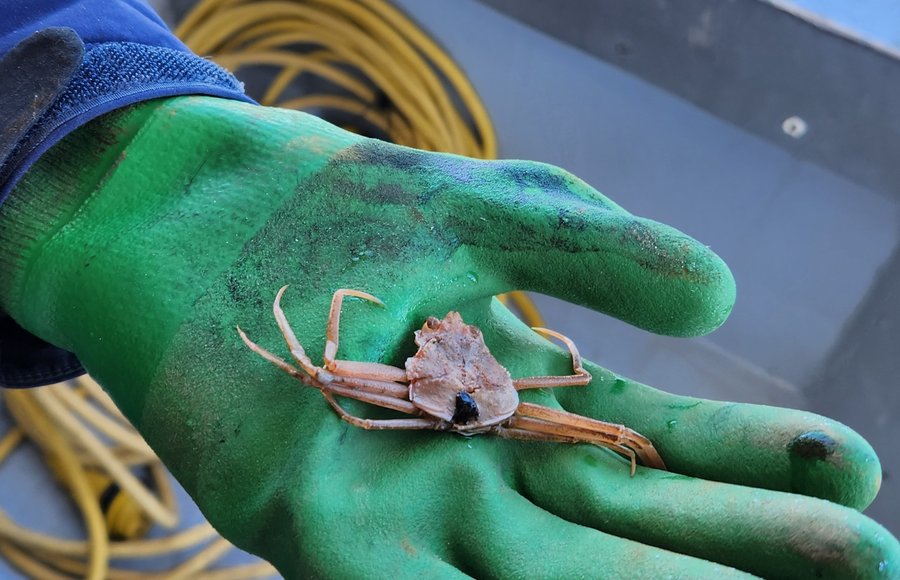
Immature snow crab found caught in the well of an OBS, before being thrown back. Photo provided by Katie Bosman.
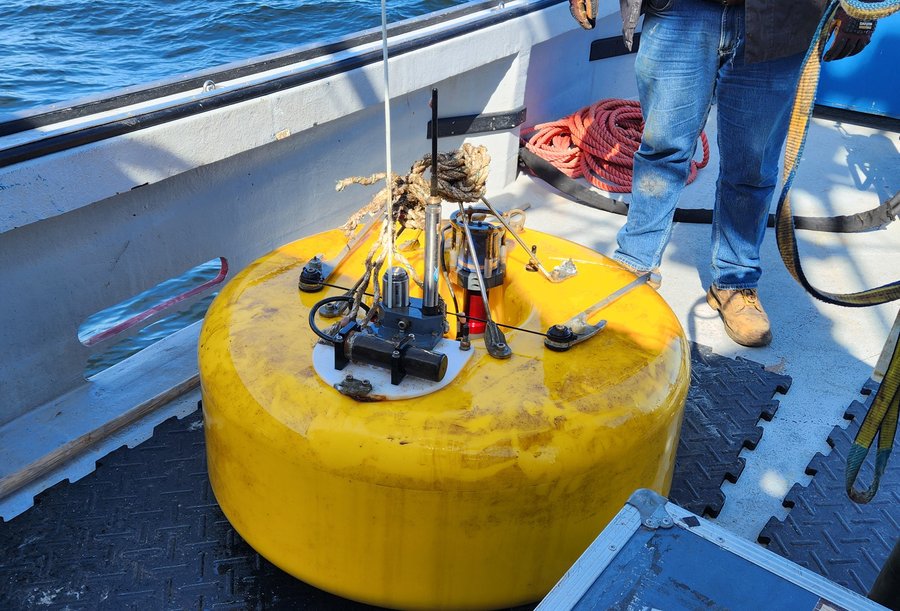
Recovered OBS sitting on deck of Island Venture 1. Photo provided by Katie Bosman.
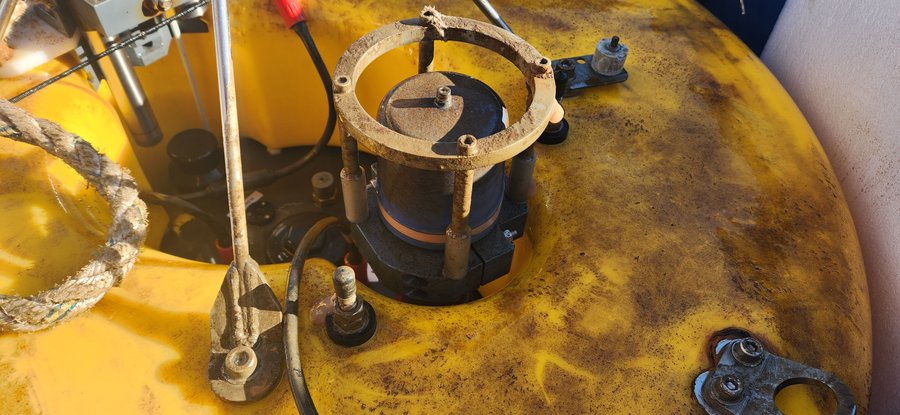
Top of OBS buoyancy unit, showing a thin coating of mud over all components. Photo provided by Katie Bosman.
Despite a few small hiccups, this was an overall successful operation. Many thanks to the crew of the Island Venture (Darrin, Blair, Joe and John) for helping to make it possible. We were also joined by Forde Nedimović, who worked with us for an internship from January to April of this year.
Of the 7 OBS recovered, 6 had full recordings for the 7.5-month deployment time. One instrument suffered an internal malfunction and only recorded for the first 6 weeks. Overall data recovery for the as-deployed array was 77% as of the end of the cruise. The original 8th instrument remained lost after surfacing in early April, but its story isn't over yet...
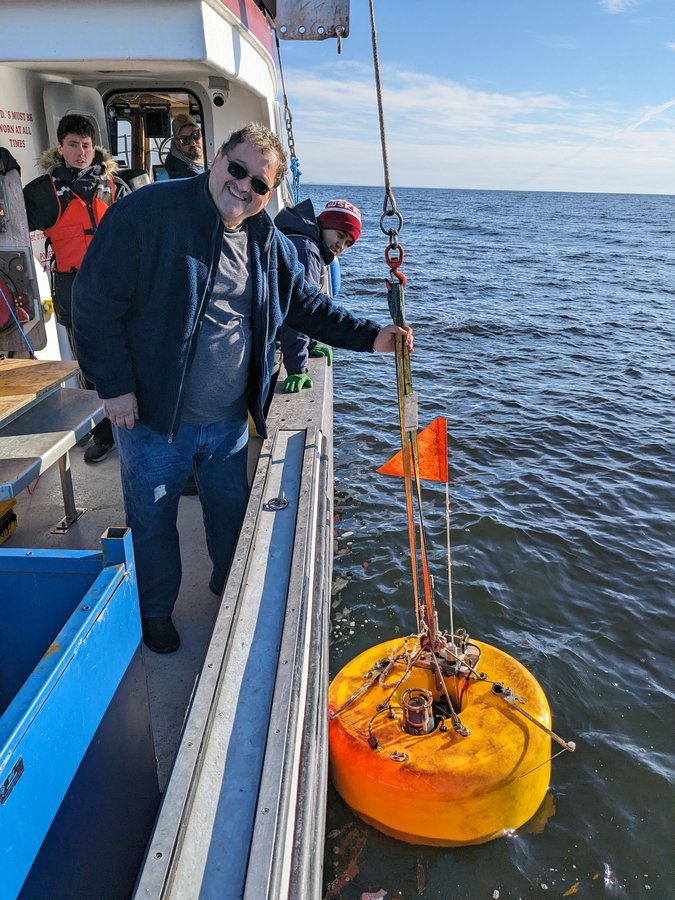
Captain Darrin Baker with the final OBS recovered from the LSLS Year 1 deployment. Photo provided by John Thibodeau.
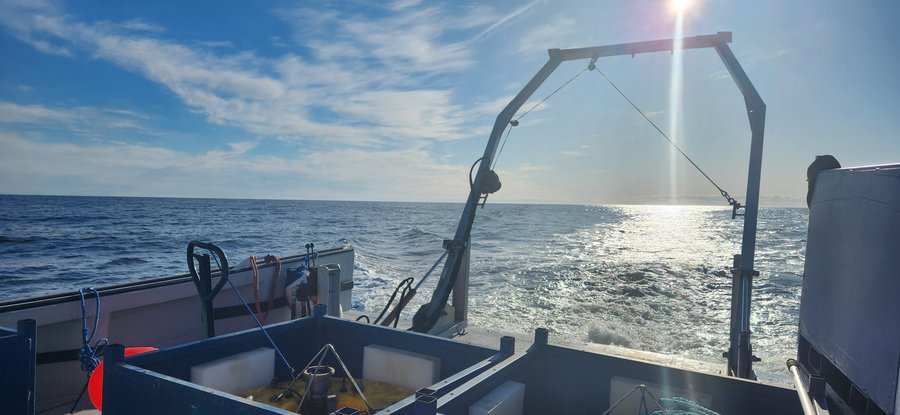
Sunny and relatively calm conditions after completing recovery of all 7 remaining OBS from LSLS Year 1. Photo provided by Katie Bosman.
The data collected from this array will be used to improve understanding of the seismogenic faults in the failed rift structure underlying the St. Lawrence River. Researchers from Dalhousie, McGill University and the Université du Québec à Montréal have begun analyzing the data. We look forward to seeing their results.
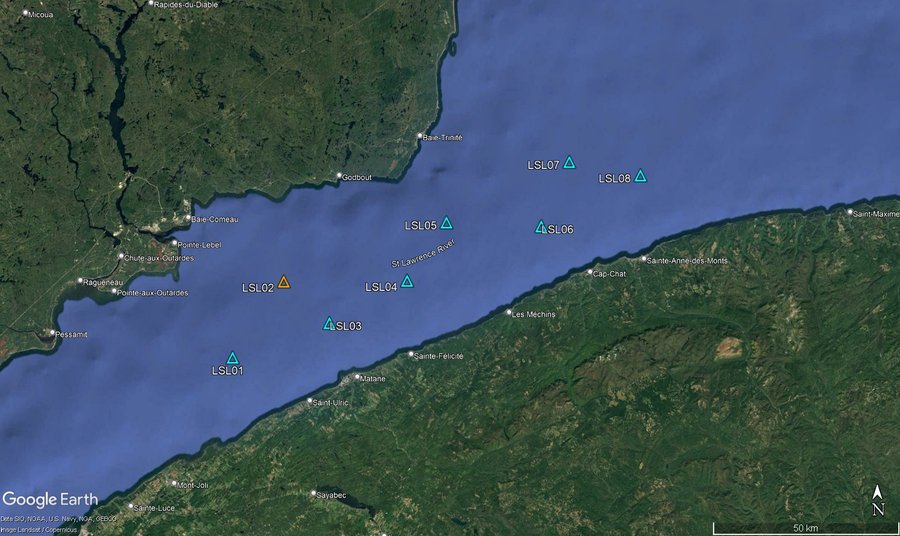
Map of stations recovered from the LSLS Year 1 array (blue triangles). Station LSL02 (orange) surfaced unexpectedly in early April 2024.
Seismic Investigation of the Scotian Margin (SeISM) Deployment
In the last week of May, we embarked on Leeway Odyssey for a deployment along the Scotian Margin with Dalhousie professor Dr. Miao Zhang. The research goal for this project is to collect data on the background noise and seismicity levels prior to potential future CO2 injection or offshore wind projects. A total of 19 BOBS were deployed in a sparse array covering over 400km of the continental slope. A planned 20th station had to be cancelled due to an instrument malfunction during pre-deployment checks. Recovery is planned for Spring 2025.
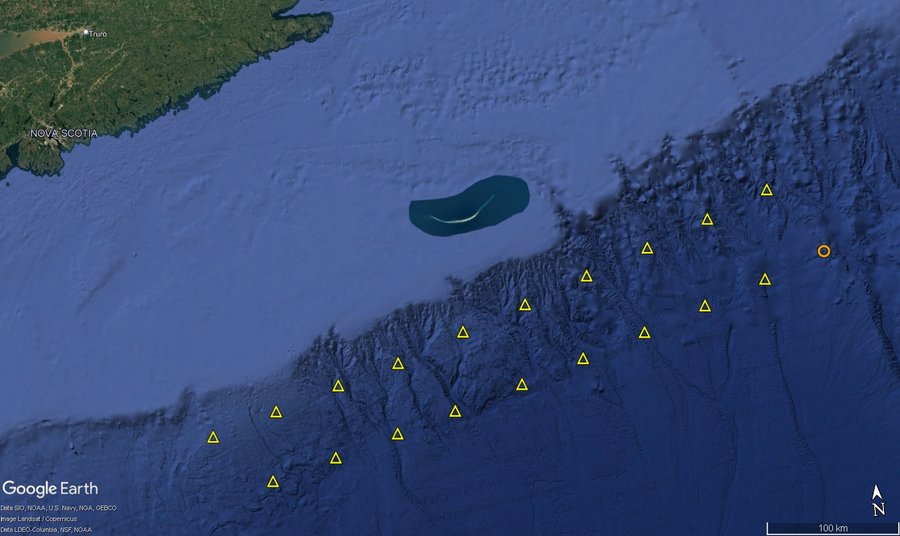
Map of stations deployed for the SeISM project (yellow triangles) along the continental slope offshore Nova Scotia. The planned 20th station (orange circle) was not deployed due to an equipment malfunction.
Overall, the deployment went well but presented a number of challenges. Mechanical issues in the engine room delayed our our first 2 attempts at departure, but third time was the charm and we were able to get underway. After the first day or two of good weather, conditions deteriorated. High sea state and the ship's propensity to roll made controlling the instruments during lift operations difficult, but everyone pitched in with manning taglines and spotting to ensure the operations were carried out safely.
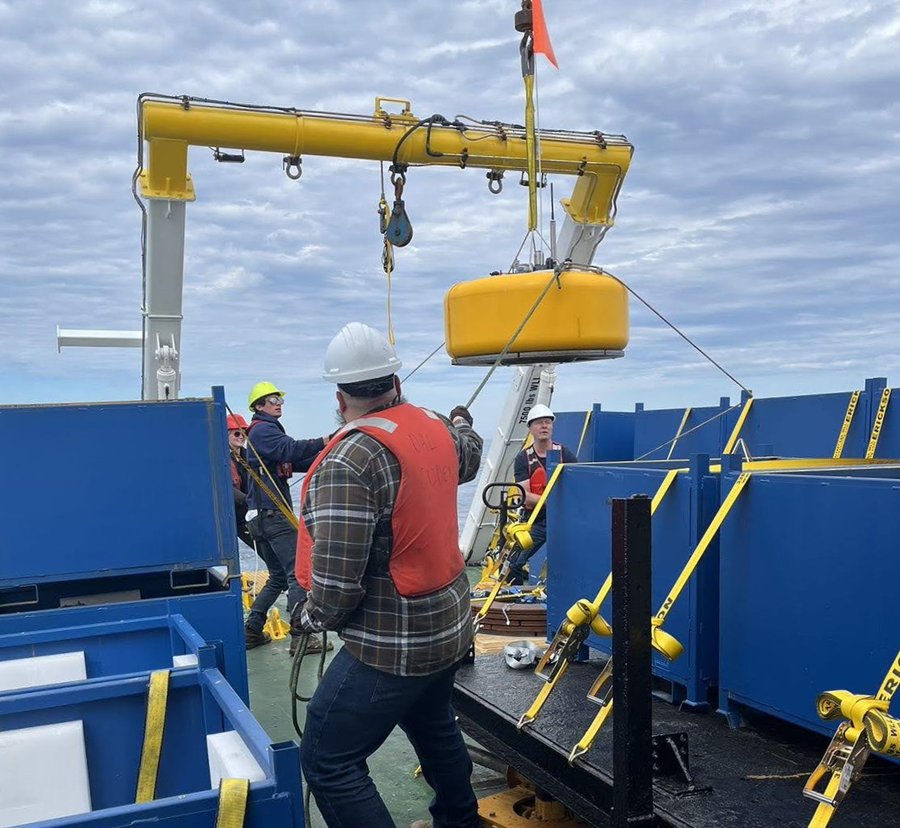
Moving an OBS from its stillage to the staging area beneath the stern A-frame with taglines. Photo provided by Miao Zhang.
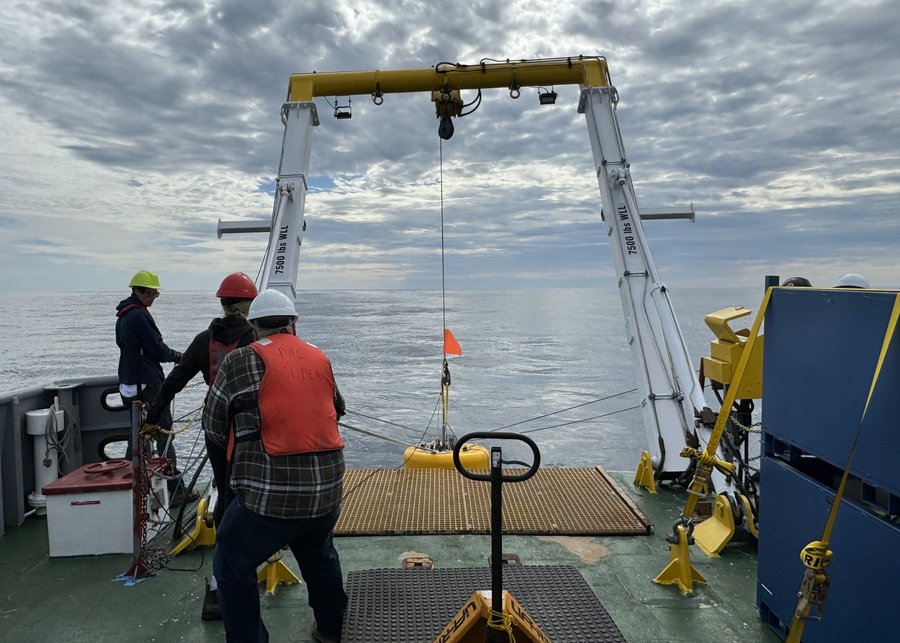
Crew and staff deploying an OBS. A total of 3 taglines were used to limit swing and twist while lowering out from the stern A-frame. Photo provided by Wenda Li.
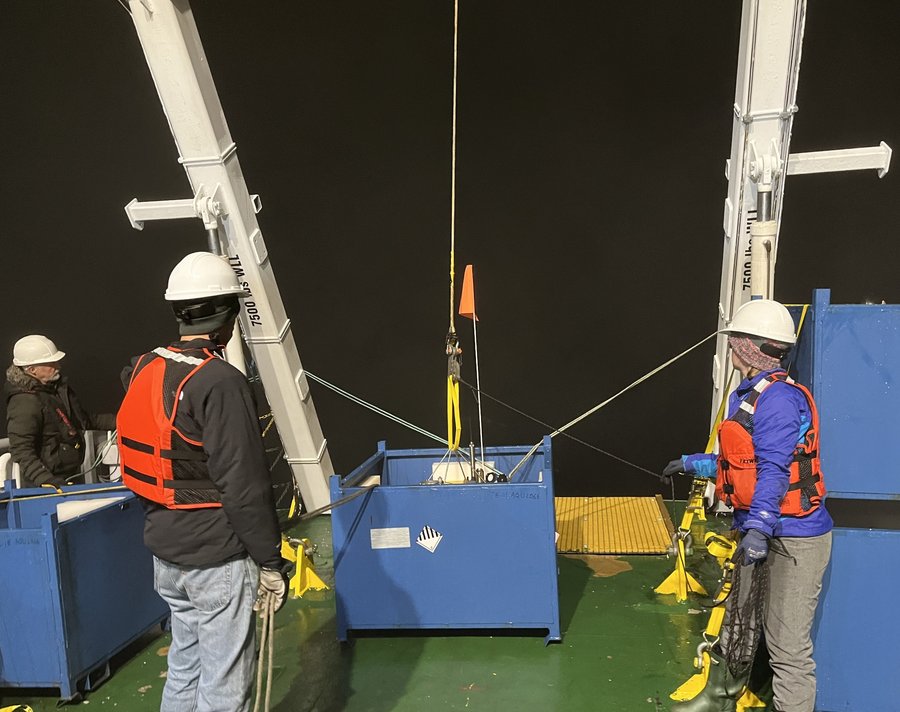
Science party and crew prepared to deploy an OBS. Photo provided by Miao Zhang.
The cable used with our acoustic dunker had been damaged during the New Zealand deployments in Fall 2023. This had been repaired onboard during that cruise, but the patch shifted strain to a different section of the cable which in turn failed during the SeISM cruise. As we depend on this dunker for deployments, it was potentially a show-stopper. Fortunately, following our NZ experience we had added cable patching equipment to our tool box, so we were able to make a quick field repair and complete the cruise objectives. On our return to Halifax, we arranged for MacArtney in Dartmouth to do a more professional repair.
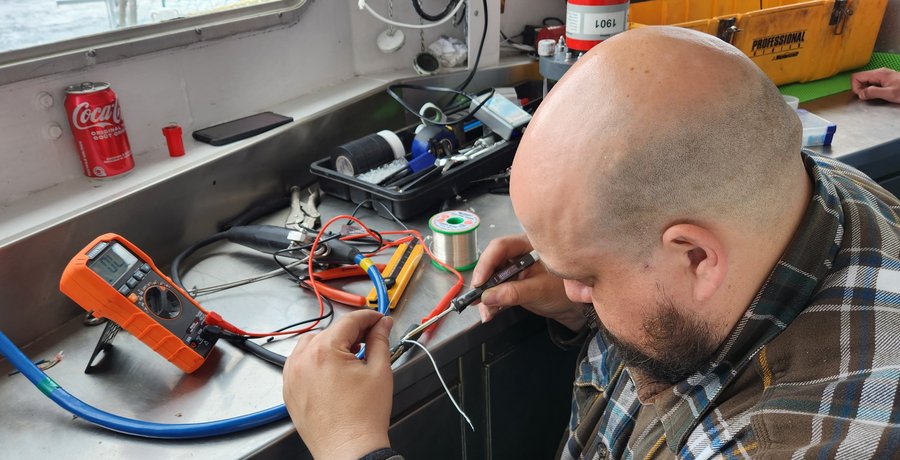
John repairing the dunker cable. Photo provided by Katie Bosman.
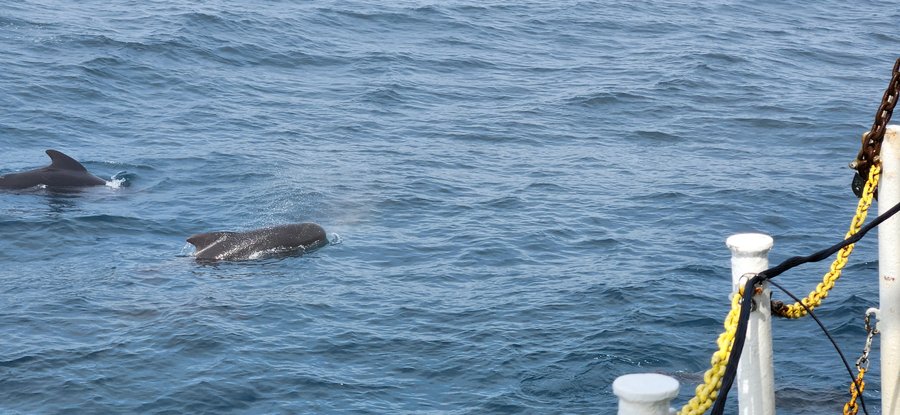
A small pod of pilot whales approaching the ship while drifting for a location survey. Photo provided by Katie Bosman.
For much of the voyage, fog reduced visibility to no more than 100 meters and there was a significant swell, especially near the shelf break. Declutching the ship's propeller to reduce surface noise during acoustic communication with the instruments led to extreme rolling while we surveyed the seafloor locations. For safety, anyone on deck during these operations was required to wear a fall harness secured to the ship. During a few surveys, small pods of pilot whales approached the ship, maybe trying to decipher the dialect of our dunker.
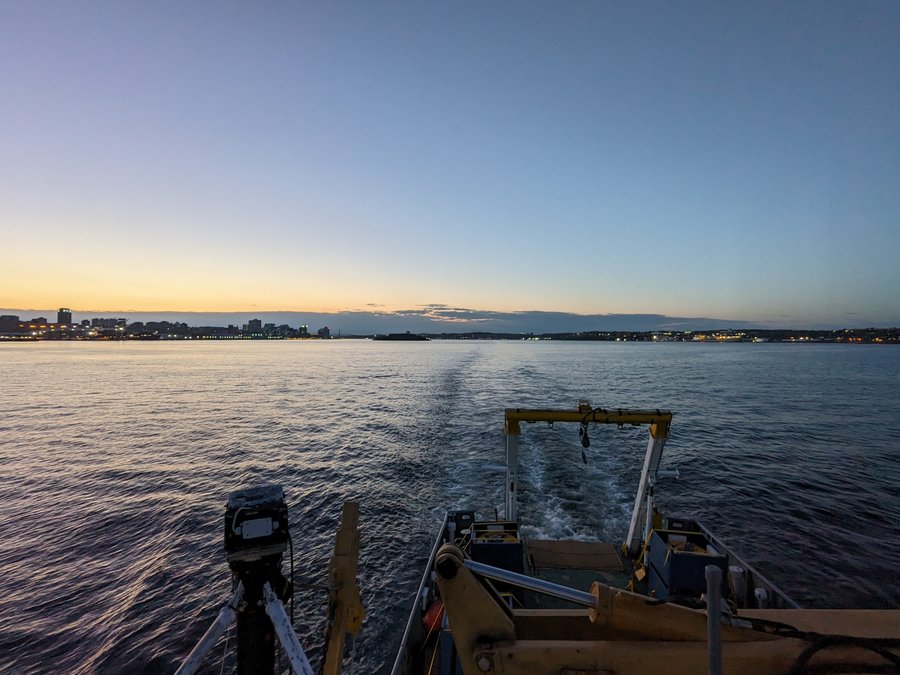
A calm clear evening steaming away from the Halifax harbour. Photo provided by John Thibodeau.
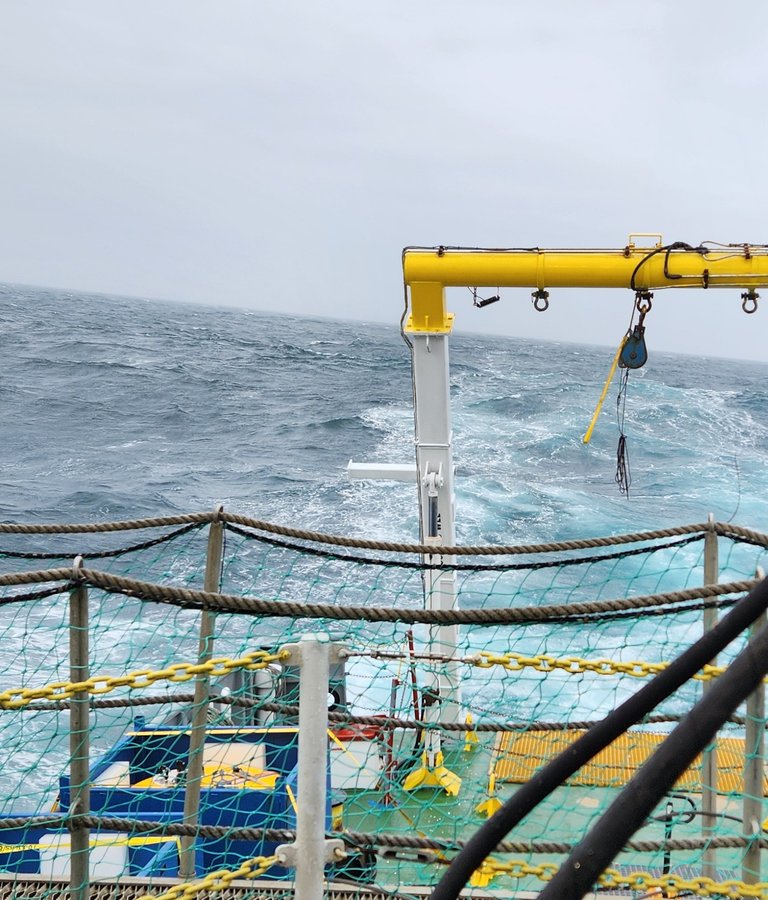
Rough sea conditions during deployment operations. Photo provided by Katie Bosman.
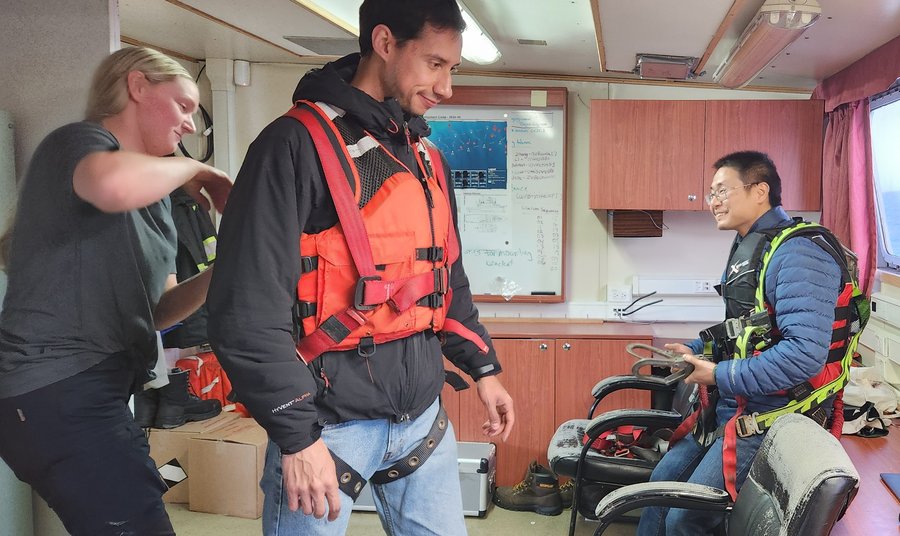
Deckhand Hannah demonstrating the fit and function of fall harnesses for Fernando and Miao. Photo provided by Katie Bosman.
Due to scheduling plans for the ship, the voyage ended in St. John's, NL, rather than returning to Halifax. Known for being one of the foggiest places in the country, St. John's did not disappoint when we arrived. In fact, our return flight to Halifax was delayed by a full day due to heavy fog making it difficult for incoming aircraft to land.

A fairly typical foggy entrance into St. John's harbour. Photo provided by Katie Bosman.
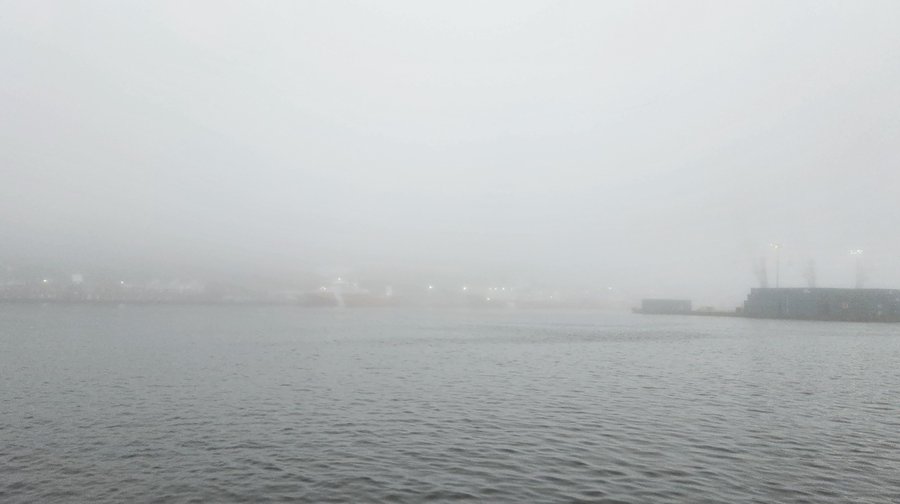
View of St. John's harbour while staff waited for a return flight to Halifax. Photo provided by Katie Bosman.
June - Maintenance & Partnership
Following our training session in late April, engineers from Ocean Networks Canada (ONC) deployed 5 of our Aquarius OBS near the Endeavor Hydrothermal Field during their annual maintenance cruise aboard the E/V Nautilus in early June. These instruments are supplementing ONC's existing monitoring network while they perform maintenance on some older equipment. NFSI staff were able to monitor the deployments remotely thanks to livestream and chat connections ONC uses to keep in touch with their stakeholders during field operations.
In the middle of June, two engineers from Güralp visited us in Halifax to perform retrofit maintenance and upgrades on one of our OBS production batches. Through discussions with them over the course of the week, we learned a great deal about how the instruments are built and serviced by the manufacturer. This is invaluable information for our in-house maintenance going forward.
While the Güralp engineers were in Halifax, another instrument that had surfaced unexpectedly on the west coast at the end of May was returned to us, giving the opportunity for a joint forensic investigation. Unlike our other drifters which all seem to have surfaced due to water ingress, this one was found to have a voltage supply wire that had been pinched against the interior of the pressure case during assembly, turning the entire instrument into an anode and causing massive corrosion and battery drain leading to a low-voltage release. This mode of failure was unanticipated. A check was immediately added to our pre-deployment testing to address this possibility, which has already saved another instrument from a similar fate (see below).
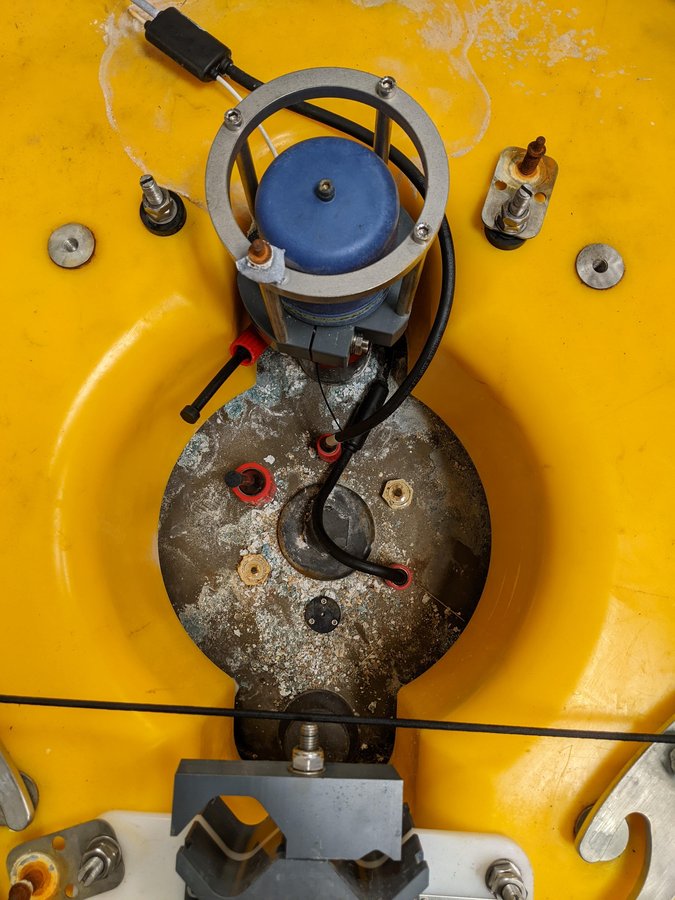
AQU-E361 (2S.L109 drifter) after recovery to Halifax. Photo provided by Graeme Cairns.
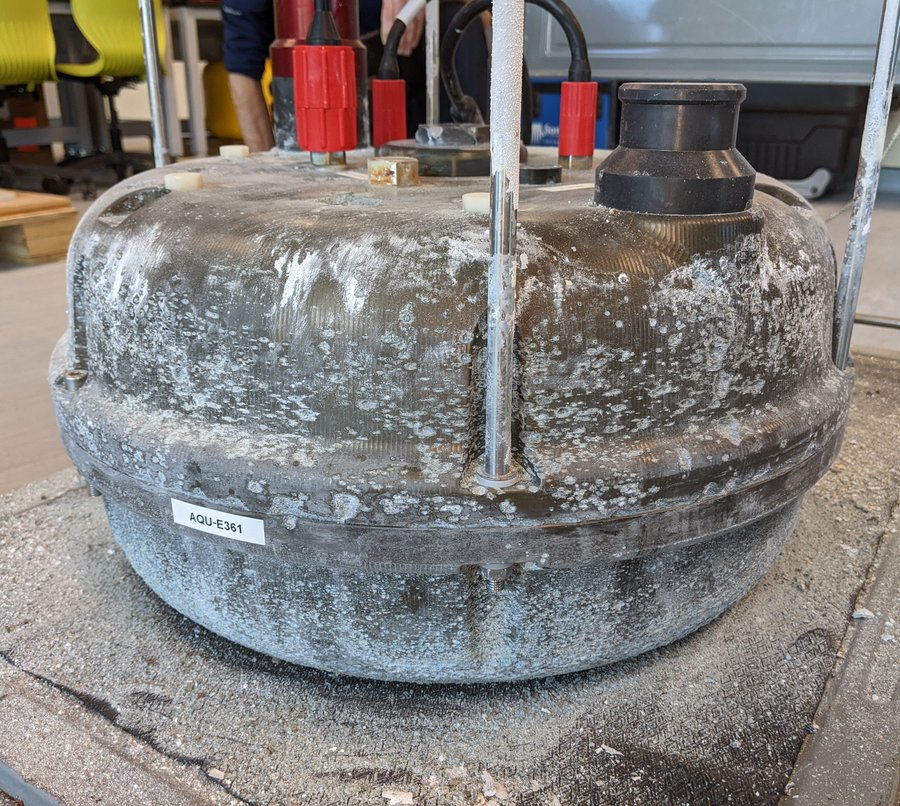
AQU-E361 pressure case showing heavy corrosion. Photo provided by Graeme Cairns.
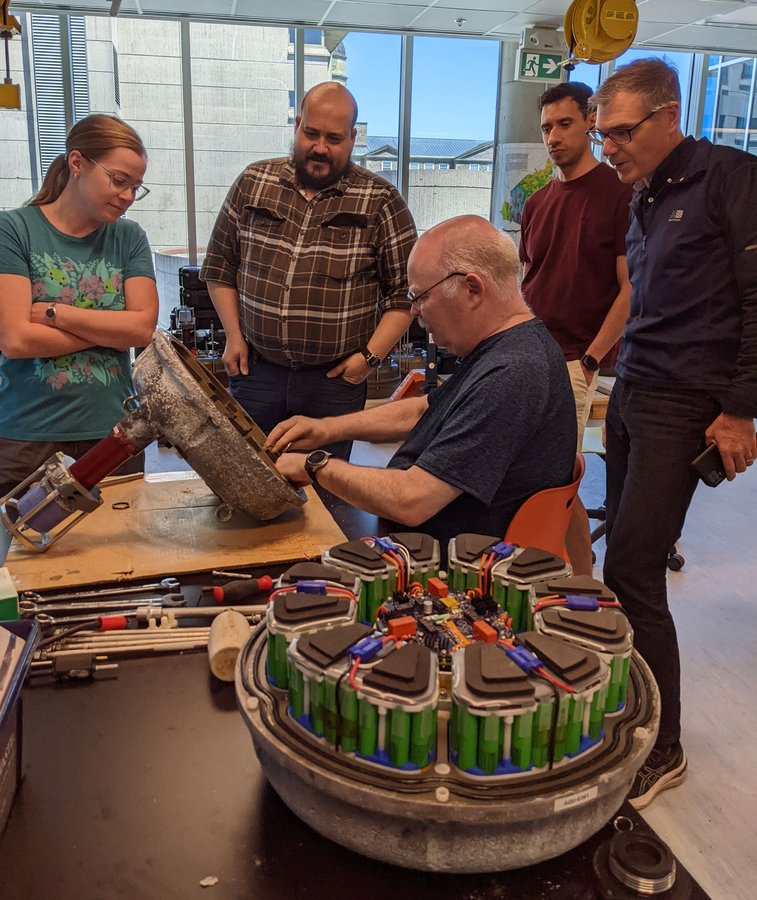
NFSI and Güralp staff examining the AQU-E361 pressure case. Photo provided by Graeme Cairns.
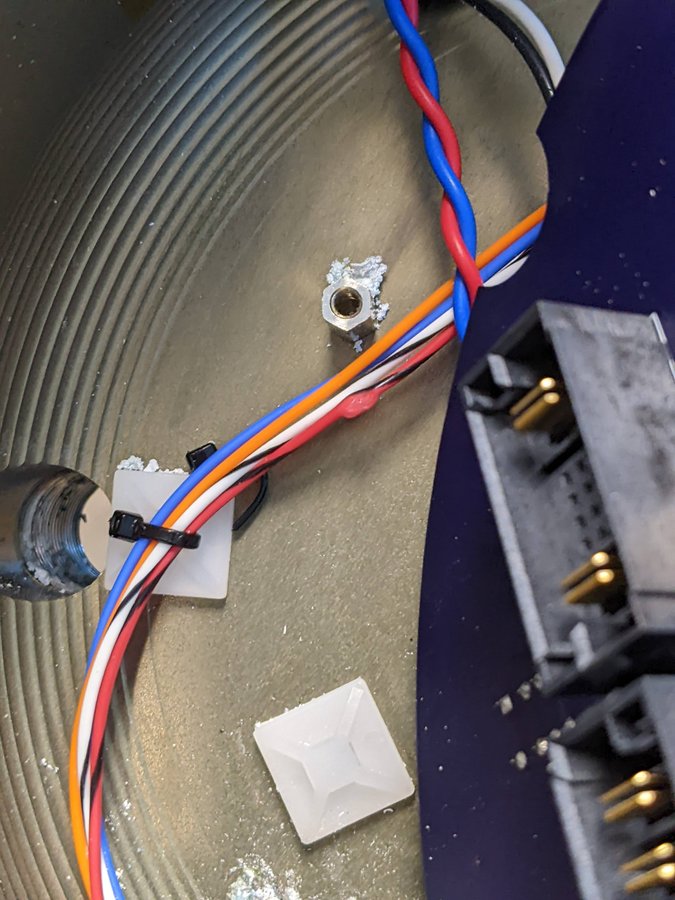
Pinched hydrophone supply voltage wire in AQU-E361. Photo provided by Graeme Cairns.
July - The Meat Grinder
Over the course of 3 weeks in July, we performed our first turn-around operation as Leg 2 of the PACSAFE project on Canada's west coast. Working with folks from Natural Resources Canada (NRCan), the University of Victoria and the Coast Guard crew aboard CCGS John P Tully, we recovered 25 BOBS, offloaded and checked all recorded data, performed basic maintenance, charged batteries, and redeployed 23 BOBS. A few instruments showed evidence of water ingress or other issues in the recorded data, and had to be sent back to Halifax for repair.
While the Leg 1 array focuses on the Revere-Dellwood Fault and Winona Basin area offshore northern Vancouver Island, the Leg 2 array extends further north across the Queen Charlotte triple junction to the southern end of Haida Gwaii. All of the recovered instruments had full recordings from the 9.5-month deployment time; factoring in the drifters, total data recovery for the Leg 1 array sits at 92%. Initial results from project researchers are very promising for the value of this dataset to understanding the seismic risk of Canada's West Coast.
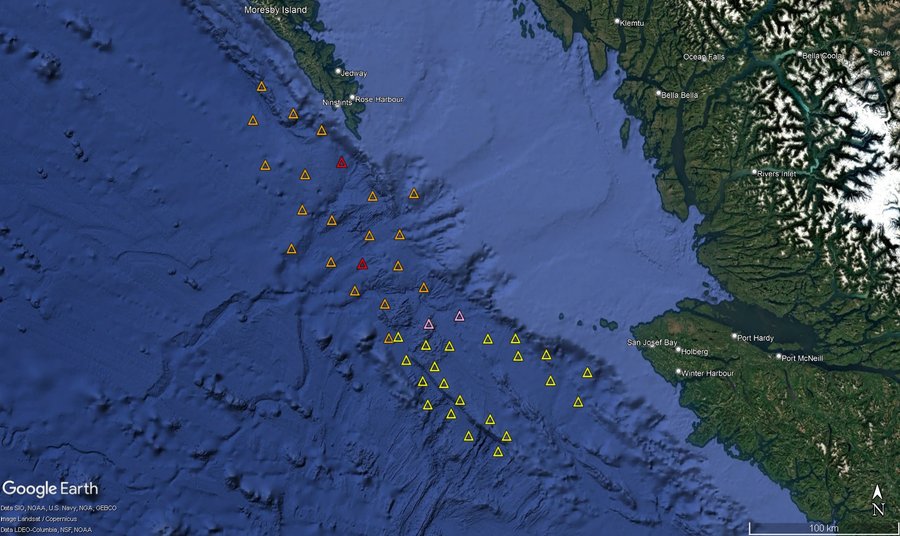
All offshore stations visited during the PACSAFE Leg 2 cruise. Recovered Leg 1 stations are shown in yellow, and new Leg 2 deployments in orange to the north. Two L2 stations surfaced a few weeks after deployment, coloured red. Two stations deployed for Leg 2 re-occupied sites of Leg 1 stations, shown as pink, to provide some overlap between the arrays.
Before sailing, two BOBS had to be reassembled at the NRCan facility in Sidney, BC (IOS). These instruments had failed some health checks when preparing for the Leg 1 deployment in October 2023 and needed to be repaired. The electronics were sent to Güralp in the UK for maintenance, while the rest of the instrument bodies remained in storage at IOS. The repaired electronics cores returned to IOS at the beginning of July shortly before we arrived for pre-cruise preparations. We also sent a few new instruments from Halifax to replace the ones which had surfaced prematurely from the Leg 1 array.
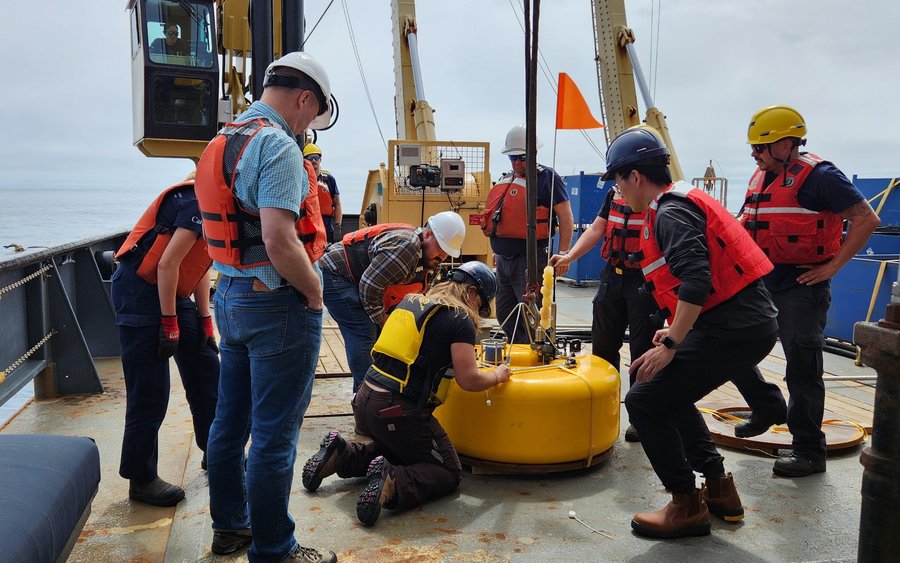
Installing a new ballast and burn-wire for a recovered OBS. Half a dozen baseball-sized clusters of fish eggs are attached to the flag pole. Photo provided by Katie Bosman.
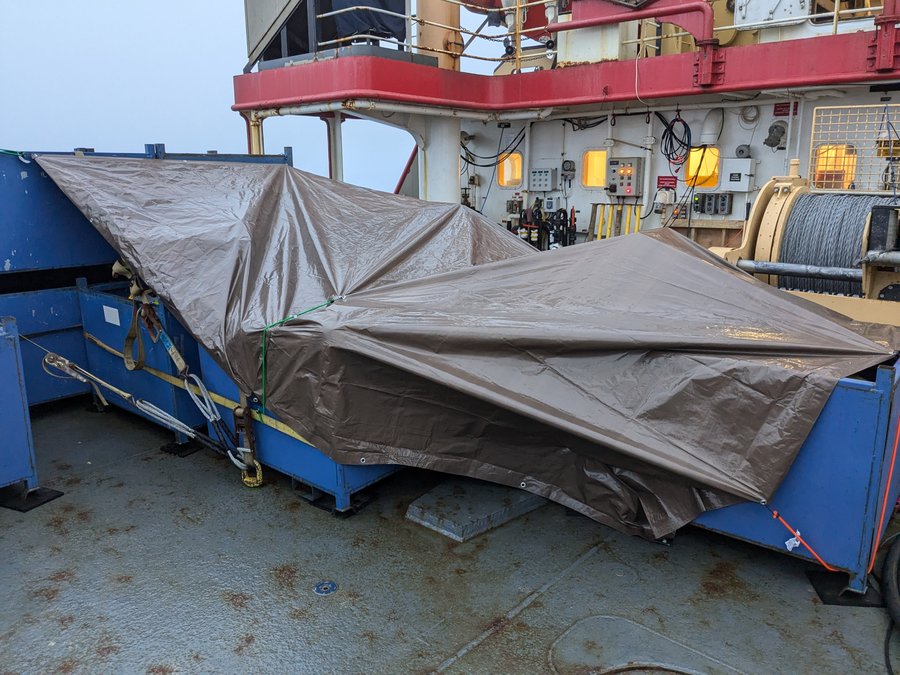
Tarpaulin lean-tos protecting the battery charger units from rain and spray. Photo provided by John Thibodeau.
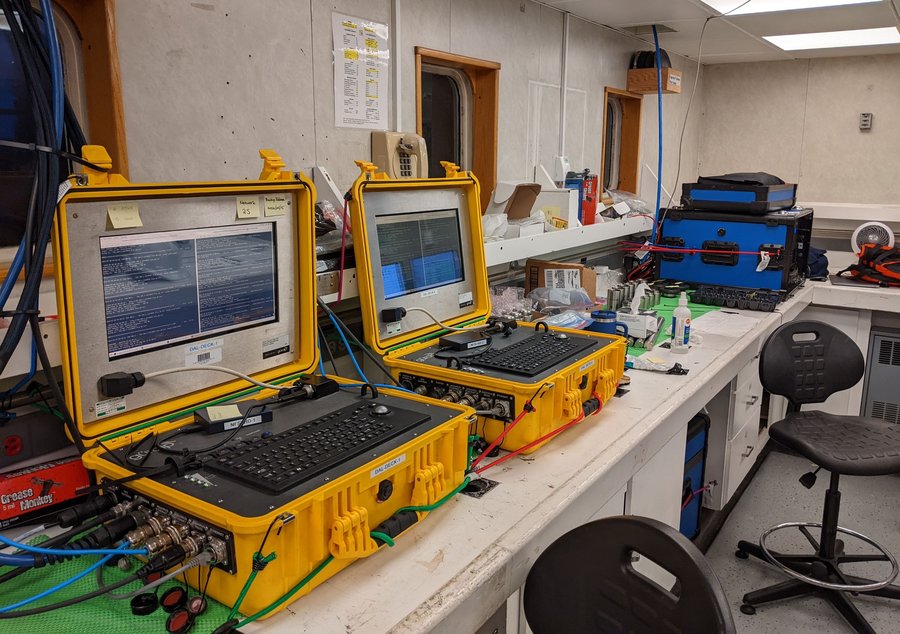
Workspace in the Tully science lab for OBS data offload and deployment programming, refit of Xeos recovery beacons, and USBL operations. Photo provided by Graeme Cairns.
As this was our first recover-redeploy cruise, there were several operational considerations that we had planned for but needed to be tweaked to work in real-world conditions. We had to be flexible with our procedures and adapt in the moment. For example, installing new ballasts is a fussy task on land to line up the attachment points and secure the burnwire, let alone on a moving ship. The science party and crew were able to integrate well and quickly find solutions when adjustments were needed, for an efficient and successful cruise. Big thanks to our NRCan Chief Scientists Tiegan Hobbs, Tian Sun and Cooper Stacey for keeping it all running smoothly.
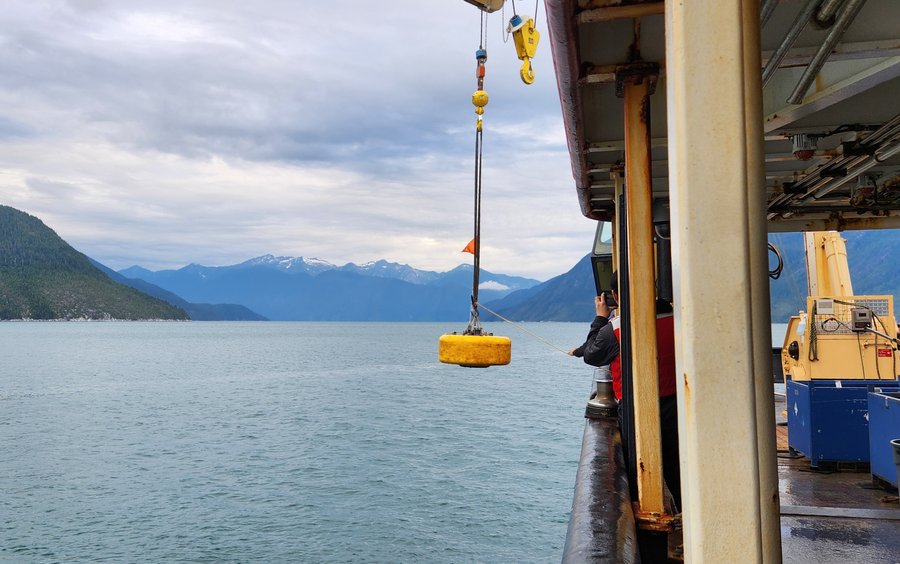
Recovering an OBS in Burke Channel. Photo provided by Katie Bosman.

Aft deck of CCGS John P Tully during transit near Haida Gwaii. Waters showing an almost tropical azure colour. Photo provided by Katie Bosman.
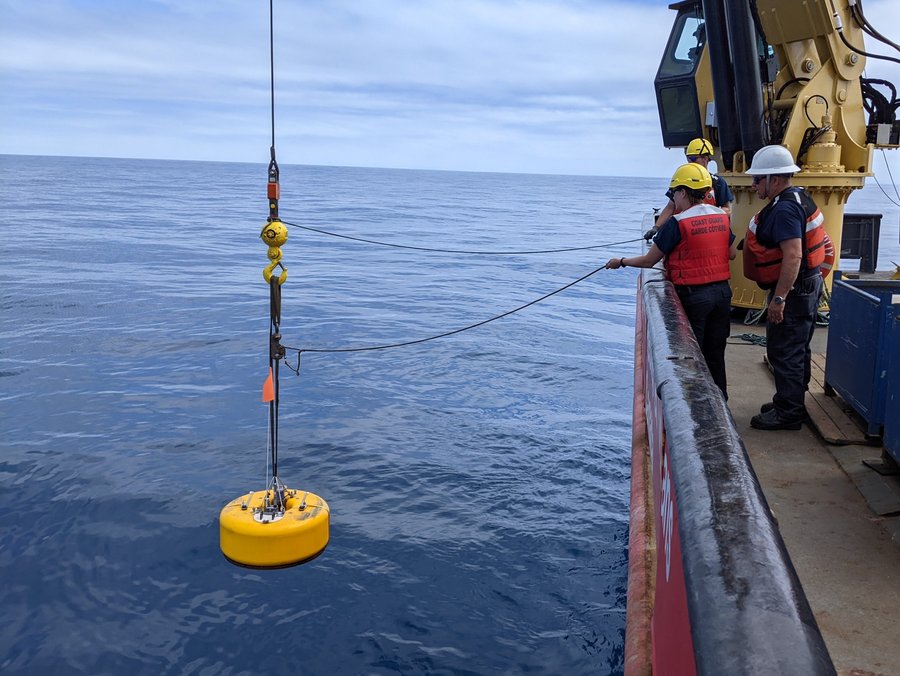
Coast Guard deck crew deploying an OBS overboard. Photo provided by Graeme Cairns.
Due to weather constraints, location surveys had not been carried out for most of the stations during the deployment cruise in October 2023, and therefore needed to be performed during the recovery. Thankfully we didn't have any significant weather delays during this year's cruise, so both the 2023 stations and all of the new deployments were surveyed with time to spare for extra NRCan science objectives before returning to port.
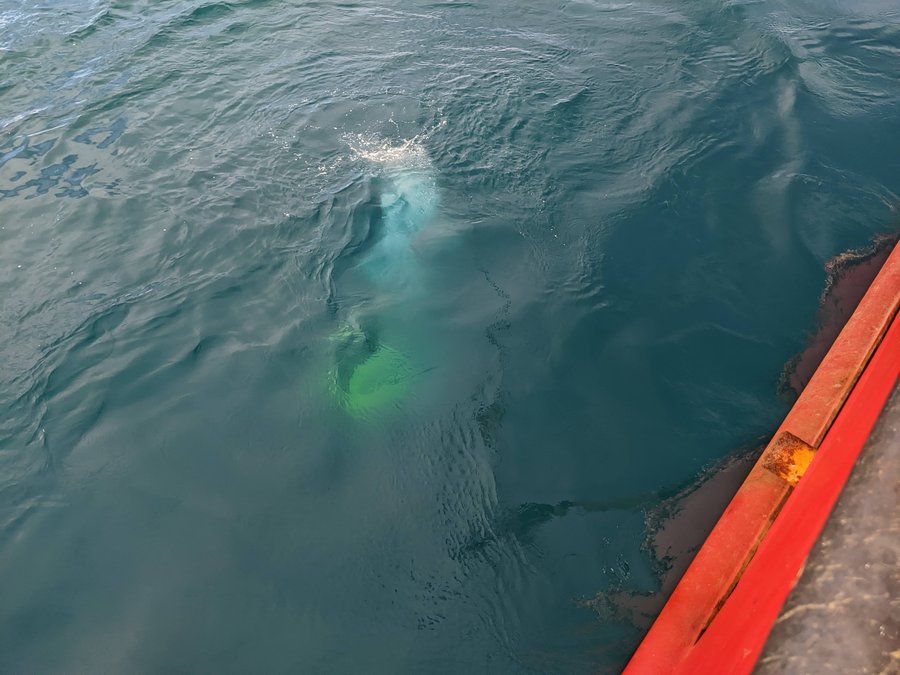
Deployed OBS sinking beneath the water. Photo provided by Graeme Cairns.
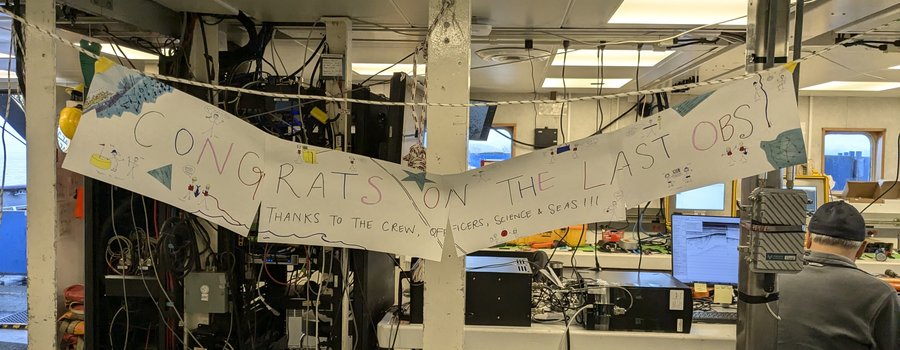
Celebratory banner hung in the Tully science lab after finishing OBS operations. Photo provided by John Thibodeau.
This cruise was long and tiring, with the OBS team constantly busy for 12-hour shifts during 24-hour operations. NFSI staff were joined by Vernon Eville, a technician from the OFI Research Implementation Unit, to give us a full 4-person team for the OBS work (2 per shift). NRCan researchers also collected seafloor samples, sediment cores and many lines of shallow seismic imaging data with a sub-bottom profiler, as well as recovering 4 ocean-bottom pressure gauges deployed by their JAMSTEC partners in Fall 2022. Everyone on board was happy to have accomplished so much, and looked forward to some well earned R&R afterwards.
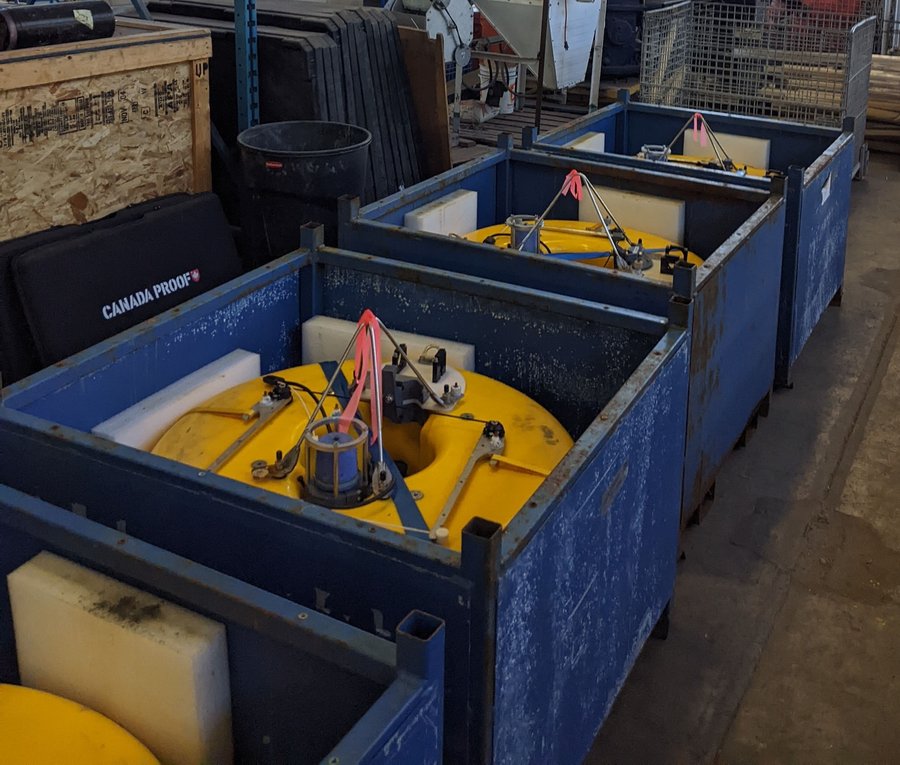
Water-damaged OBS being prepared for shipping to Halifax for maintenance. Photo provided by Graeme Cairns.
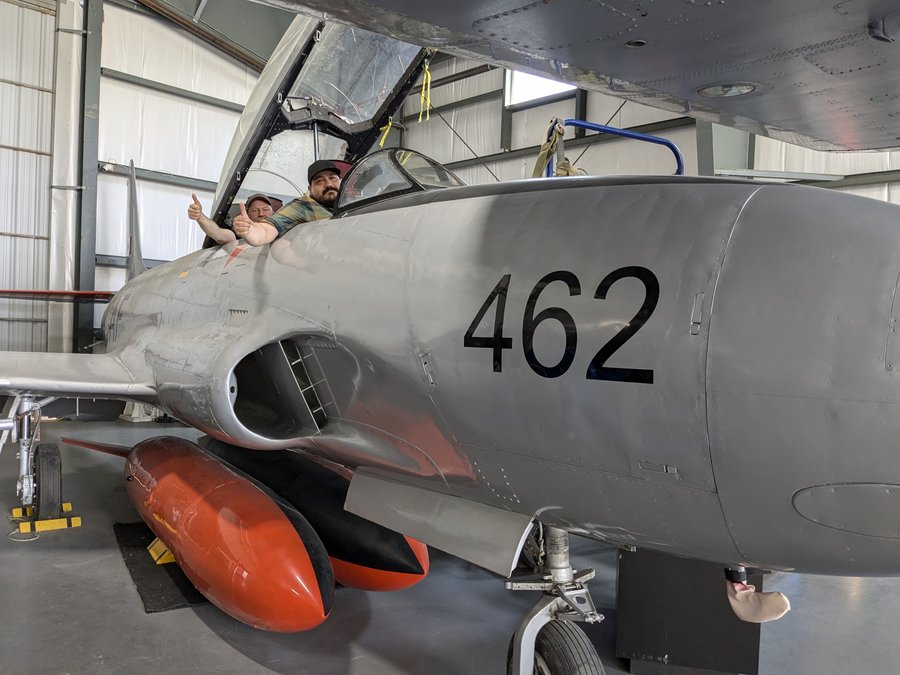
NFSI staff ready to fly home. Photo provided by John Thibodeau.
August - Full Speed Ahead
While wrapping up the B.C. operation, we received final approval from partners at DRDC for a deployment in northern Baffin Bay for September 2024. The timeline to prepare for this project was short, as we didn't return from B.C. until the beginning of August and needed to send instruments and other equipment on a ship to the Arctic about 3 weeks later. Also, some of the BOBS we hoped to send to Baffin only returned to Halifax in mid-August following RMA maintenance by Güralp.
An additional stress was created by the fact that the Canada Foundation for Innovation (CFI) grant which funded the startup phase of the NFSI facility was set to expire on September 30, 2024. Due to delays in instrument deliveries and testing caused by COVID, a significant amount of money intended to fund field tests and buy critical equipment remained in the grant. If not spent by the deadline, this would be lost. While Mladen and Graeme worked with the Dalhousie grant facilitation committee to request an extension, we raced to purchase as many of these items as we could before the deadline.
In a fortuitous turn of events, we received a message from a resident of Gaspé, QC, in early August that he had found our drifting OBS from the St. Lawrence deployment washed up on a beach, some 250 km downstream from where it surfaced 4 months earlier. With our contact information attached to the buoyancy, it was easy for him to reach out to us. He was able to pull the instrument off the shore at high tide and store it at a local workshop until we could collect it later in the fall. Some physical damage was clear from the photos he sent us, but the full extent of it wouldn't be known until we could inspect for ourselves.
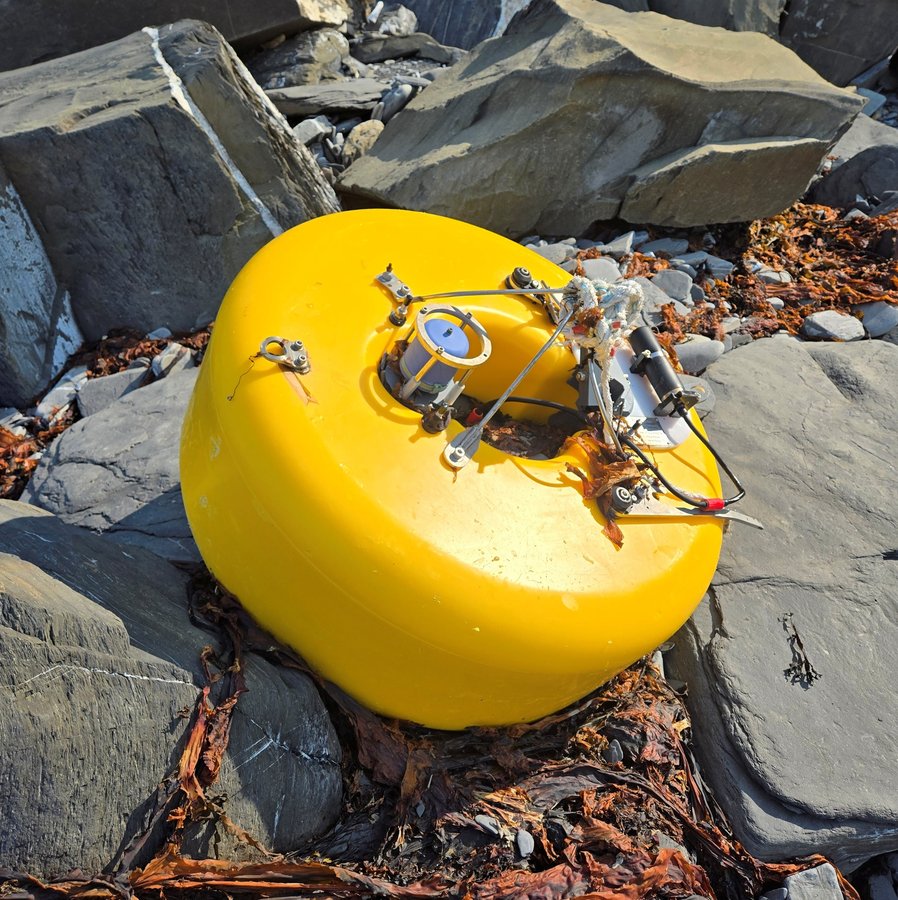
AQU-4D5C (LSL02 drifter) washed up on a rocky beach in Gaspé. Photo courtesy Mathieu Bernier.
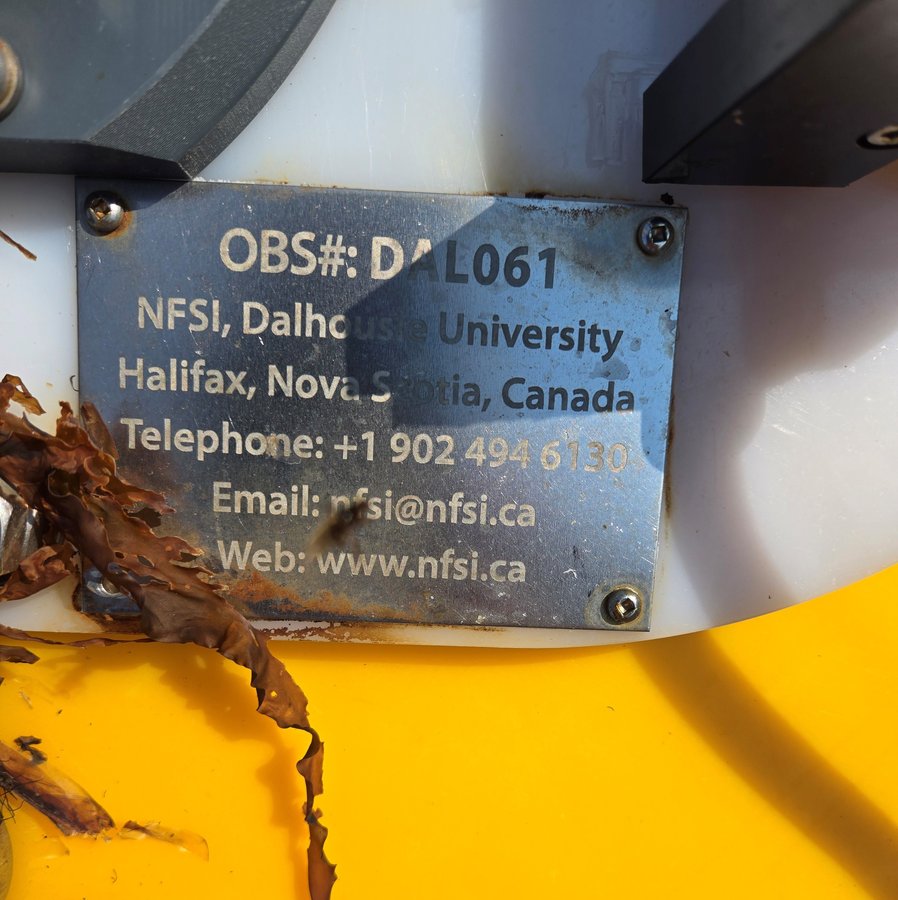
NFSI name plate installed on AQU-4D5C with contact information. Photo courtesy Mathieu Bernier.
Just before leaving for Baffin Bay, we carried out another forensic investigation with Güralp for three instruments which showed evidence of water ingress during the PACSAFE operation in July. Once again, low level leakage was clearly happening through the electrical connectors. Despite detailed examination, however, no "smoking gun" was found that revealed the exact mechanism of leakage.
September - Venturing North
To round out our whirlwind summer, NFSI staff were in northern Baffin Bay for a few weeks in September to deploy another array of BOBS for the Baffin Island Broadband Offshore Seismology (BIBOS) experiment in partnership with DRDC. This project will study the rift structure beneath Baffin Bay, the Davis Strait and the Labrador Sea as part of a larger multi-year monitoring effort (ICE-OBS) spearheaded by researchers at Dalhousie and McGill Universities.
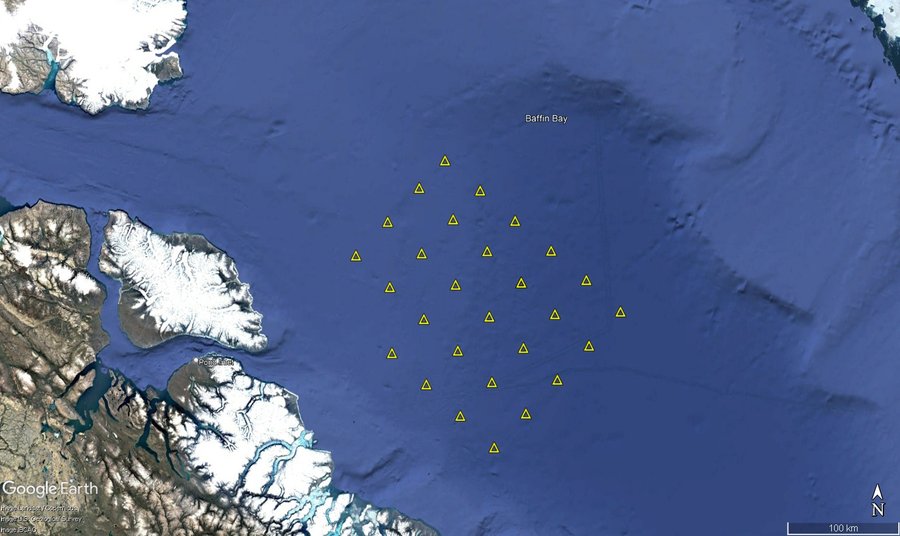
Array of 28 Aquarius BOBS deployed in northern Baffin Bay for the BIBOS project.
NFSI staff traveled to Pond Inlet to meet the Mersey Venture, a fishing trawler based in Liverpool, NS, which regularly plies the Arctic waters for cold water shrimp and other species. After a short transit, we deployed 27 stations of the main array in Baffin Bay. We then headed over to northern Greenland to deploy one instrument for testing near other DRDC equipment, before returning to deploy the final station of the main array during our transit south. The cruise ended in Iqaluit where we offboarded, while the ship continued back to Nova Scotia.
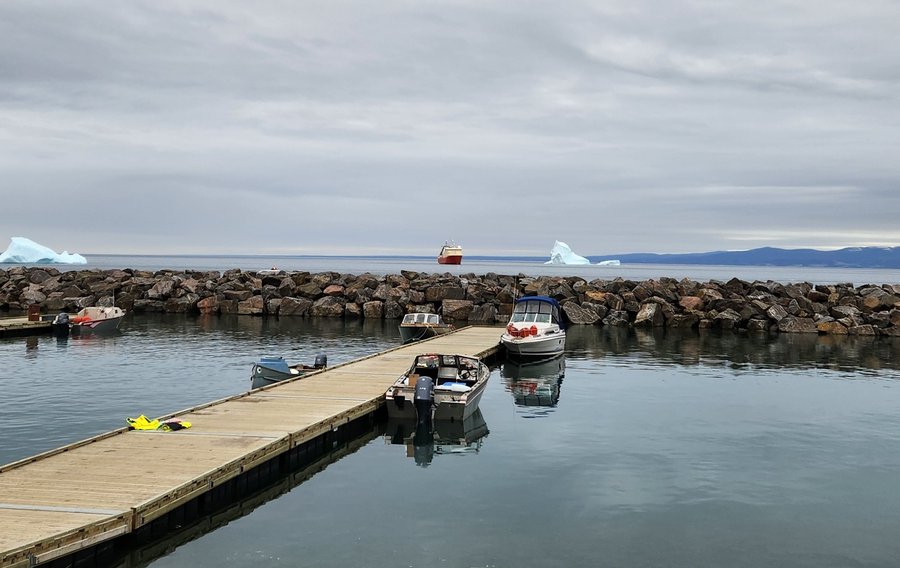
First view of Mersey Venture from Pond Inlet harbour. Photo provided by Katie Bosman.
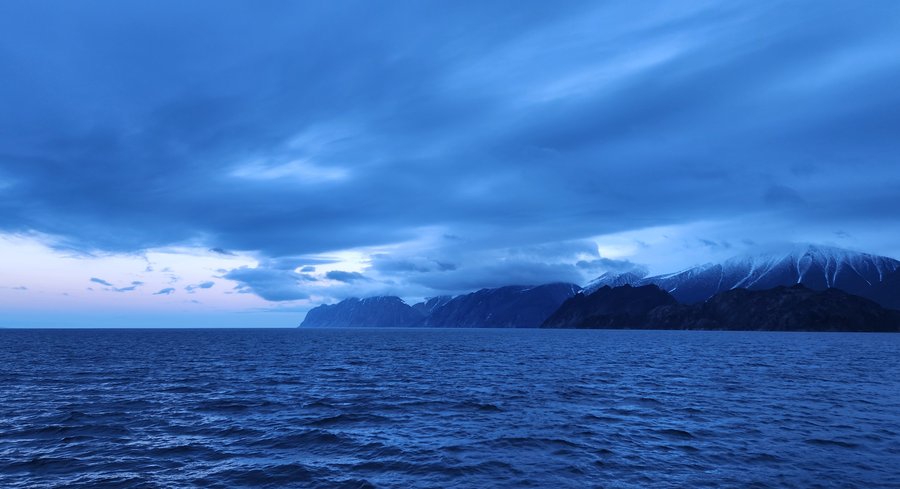
Rugged mountains near the exit from Pond Inlet. Photo provided by Katie Bosman.
This was our first experience working with a large commercial fishing vessel. Overall, we found it well-equipped for OBS operations, with ample storage and work space. The crew were very friendly, helpful, and creative in finding operational solutions, leveraging their vast experience in getting equipment in and out of the water. Deploying from the high freeboard of such a large vessel presented some challenges but we quickly developed appropriate procedures. Recovering instruments from such a height will be more difficult - an issue we will need to deal with in 2025.
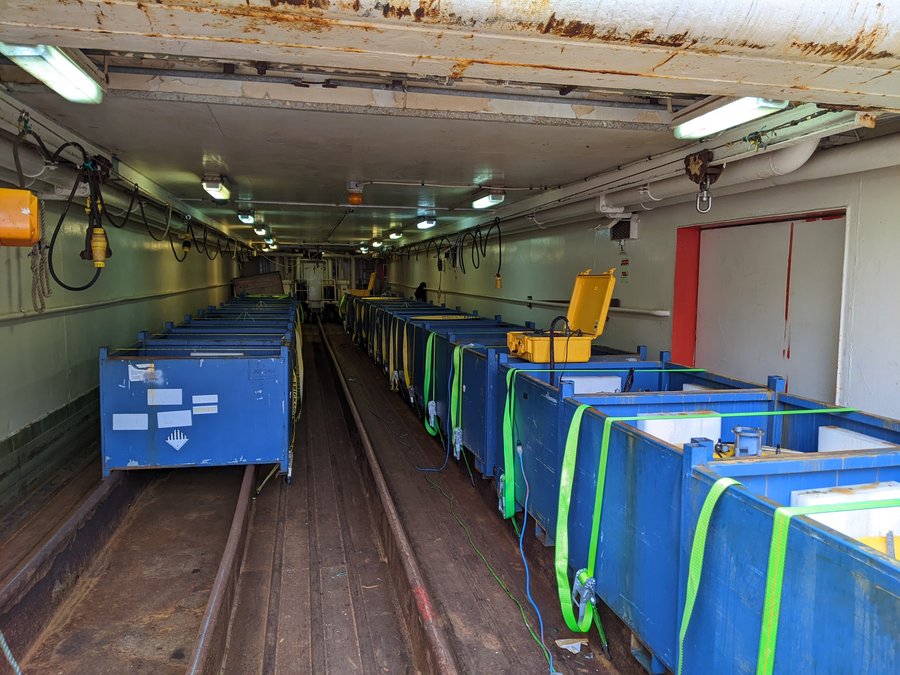
Charging the last few OBS in a large storage area on the trawl deck. Photo provided by Graeme Cairns.
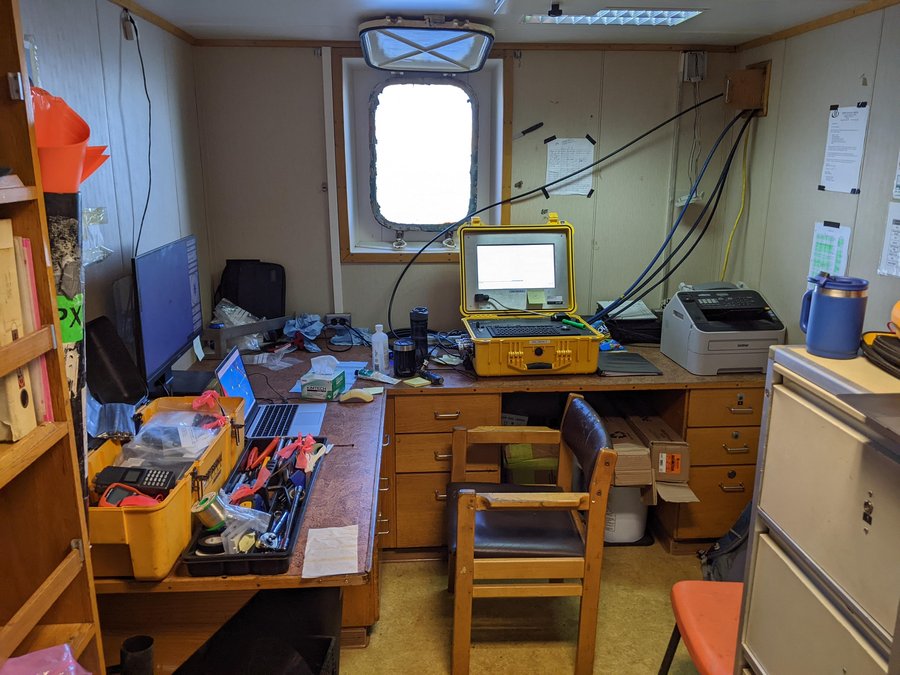
Compact but convenient lab/office space near the staging area. Photo provided by Graeme Cairns.
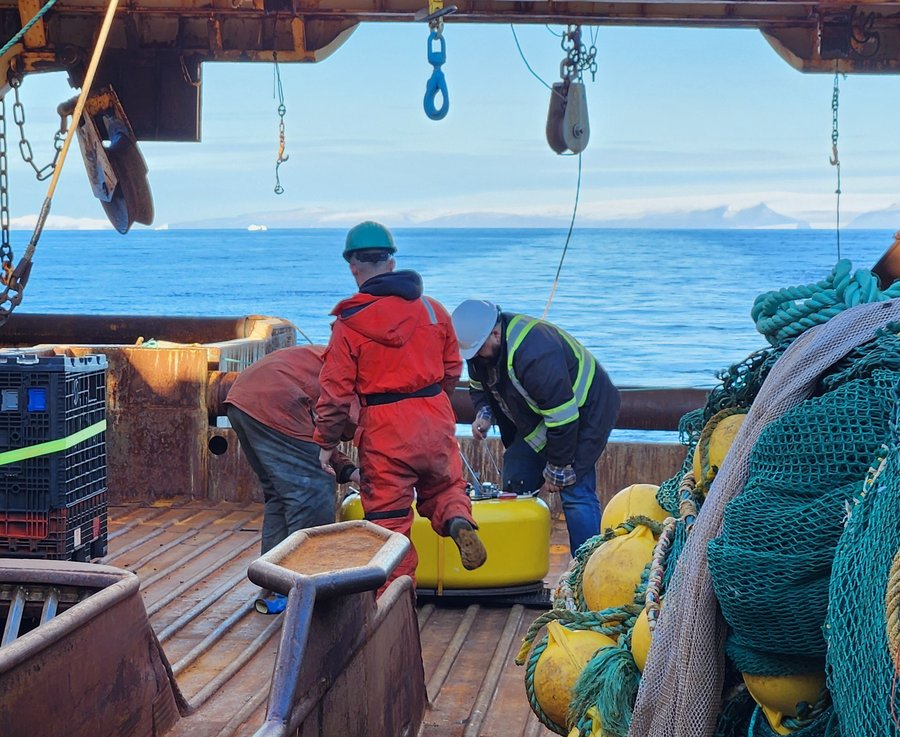
John and deckhands Ted and Curtis working on an OBS on the aft deck. Photo provided by Katie Bosman.
Of the 30 OBS we took north, 28 were deployed in a grid between northern Baffin Island and the Canada-Greenland EEZ boundary. One instrument surfaced unexpectedly a little over a day after deployment and had to be recovered. On-deck troubleshooting showed evidence of significant damage to the internal electronics, likely caused by water ingress, putting this one in the repair queue. An alternate instrument was deployed in its place in order to not leave a hole in the grid. The final instrument was deployed near some other DRDC equipment near the outlet of Bylot Sound in northern Greenland due to a request that arose shortly before the cruise.
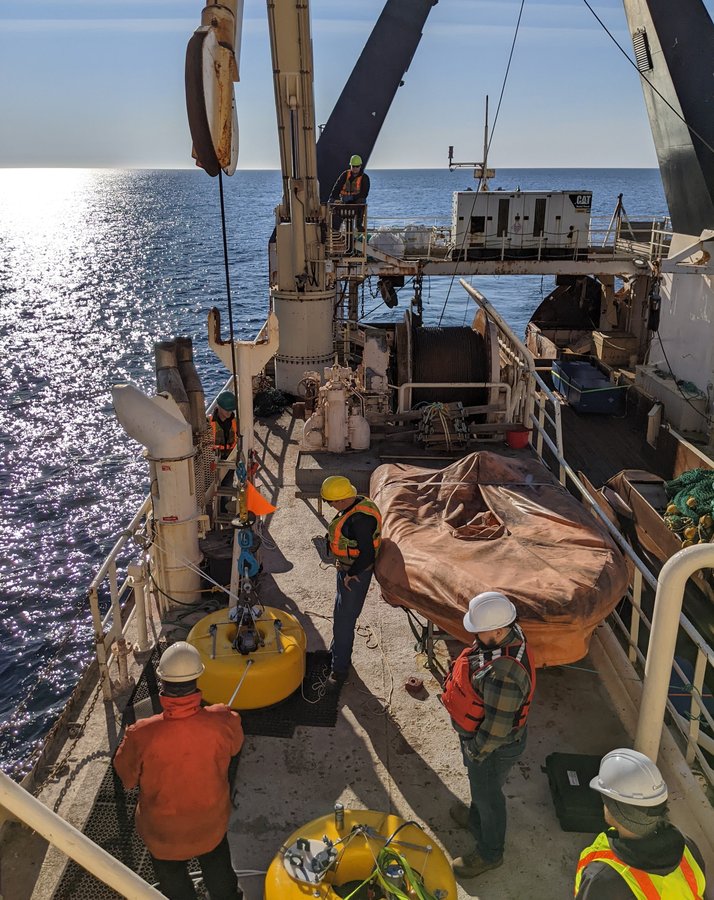
Preparing an OBS for deployment from the staging area. Photo provided by Graeme Cairns.
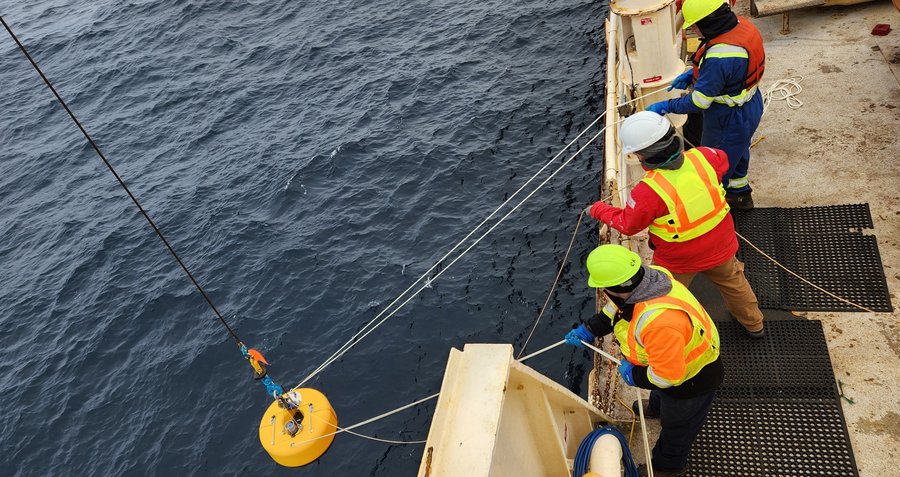
Deploying an OBS. Using two taglines minimizes twisting during the long lift down to the water. Photo provided by Katie Bosman.
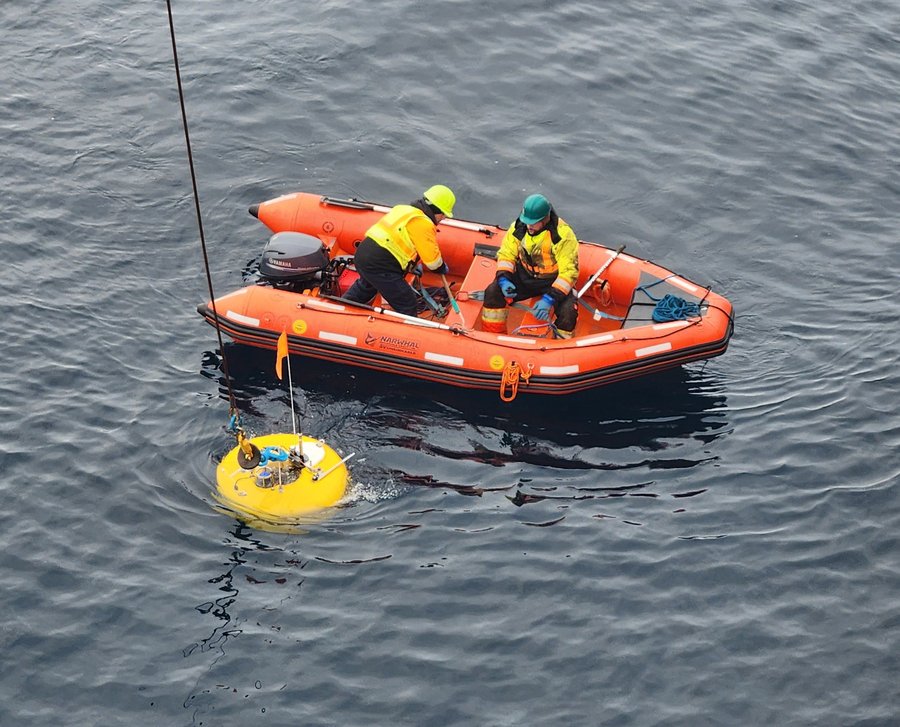
Recovering malfunctioning OBS using the zodiac. Photo provided by Katie Bosman.
During pre-deployment checks, one instrument showed a residual voltage on the pressure case, which is a test implemented in response to the anode drifter we analyzed in June. As the ship's engineers had a small hoist and vacuum pump on hand which we could use to open and then reassemble and test the instrument pressure case, we were able to investigate the issue on board during transit. Our examination found a low voltage wire pinched against the pressure case, energizing it. This was easily fixed. The instrument was reassembled, tested normally, and deployed with no issues.
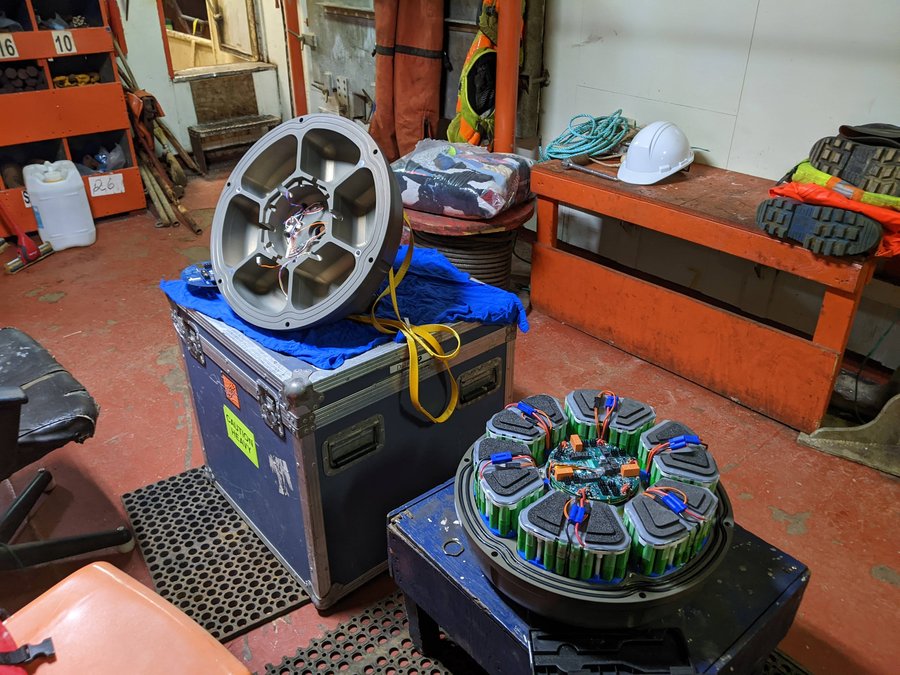
AQU-6366 pressure case disassembled for repair in rigging room. Photo provided by Graeme Cairns.
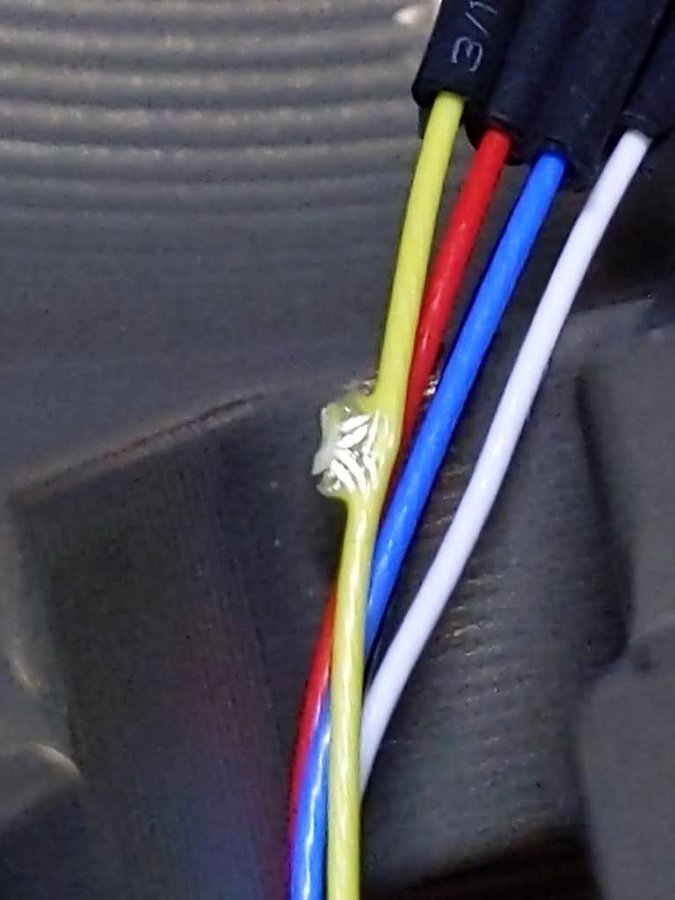
Pinched wire found inside AQU-6366. Photo provided by Graeme Cairns.
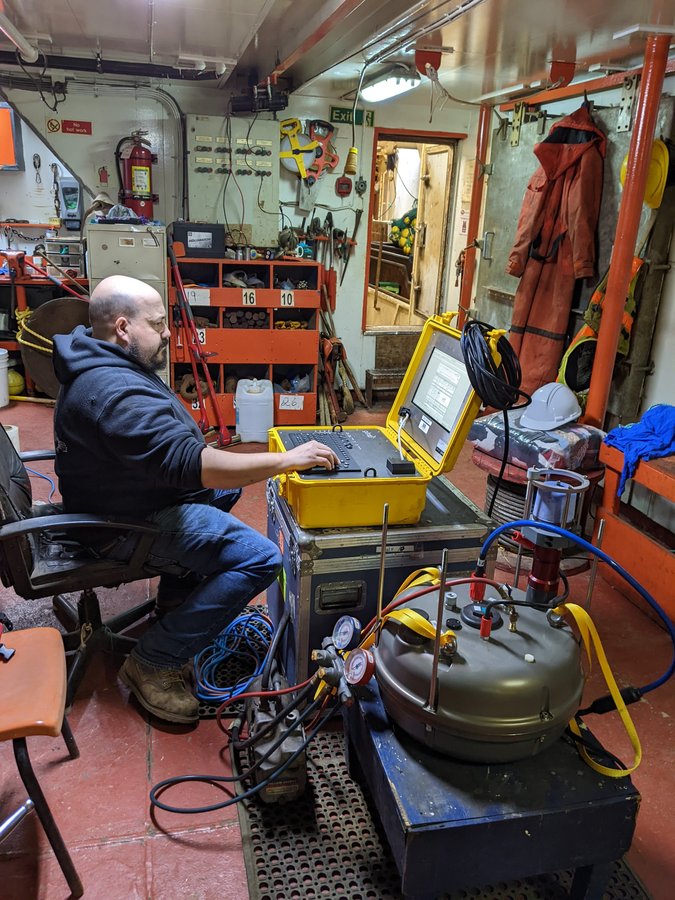
John testing reassembled pressure case. Photo provided by Graeme Cairns.
Going to the Arctic was a new experience for us. It was exciting to see such a unique environment. There were many icebergs floating around in the deployment area, which was apparently unusual for this time of year according to the ship's crew. Strangely, apart from seabirds we saw no marine life, which the crew said was also very unusual. We saw the northern lights over the last few nights of our transit down to Iqaluit after finishing operations, although it was difficult to get photos of the best displays.
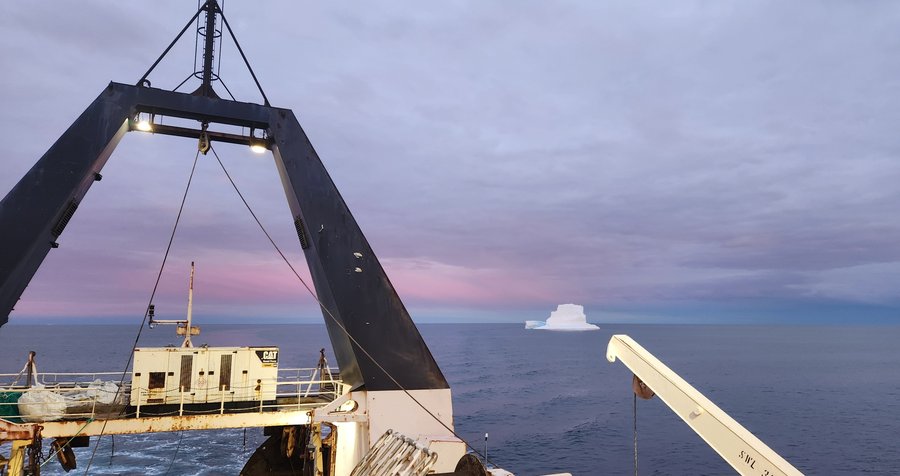
Mersey Venture fantail with iceberg and pre-dawn colour in the clouds. Photo provided by Katie Bosman.
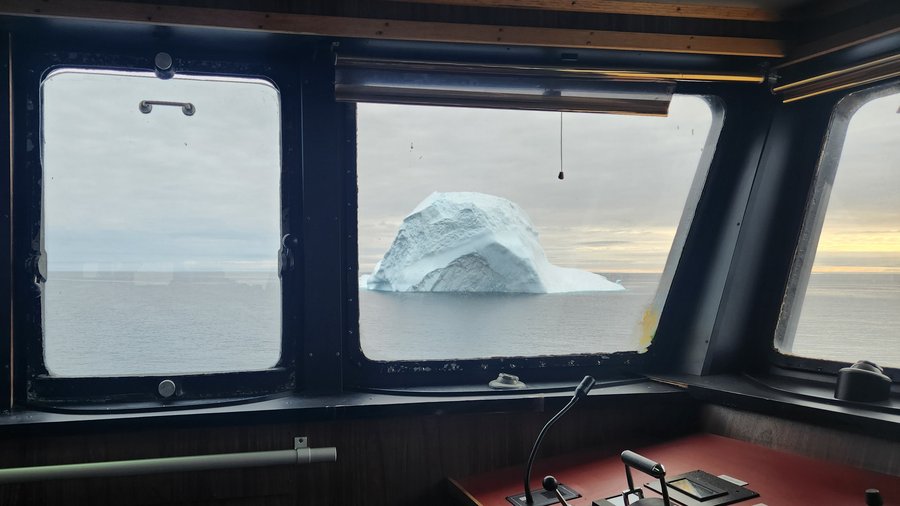
Iceberg seen from the wheelhouse windows. Photo provided by Katie Bosman.
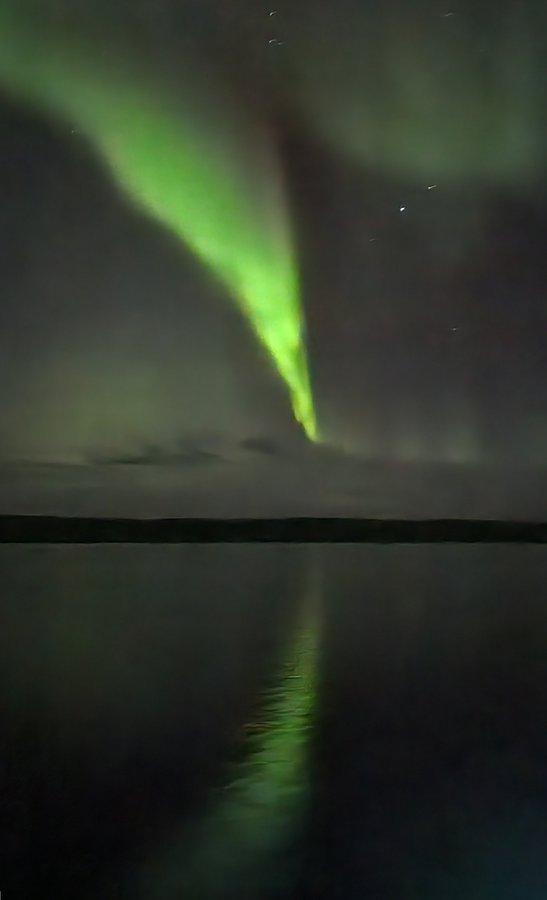
Aurora borealis near Iqaluit. Photo provided by Katie Bosman.
Although it was overcast during the day for most of the voyage, we were treated to several spectacular sunrises and sunsets. Other than the clouds and a small amount of fog the first few days, the weather was almost perfect for the entire trip. The crew remarked how unusual it was to have such a long stretch of calm so late in the summer up north. Hopefully we'll have the good luck of similar conditions when we return for the recovery in 2025.
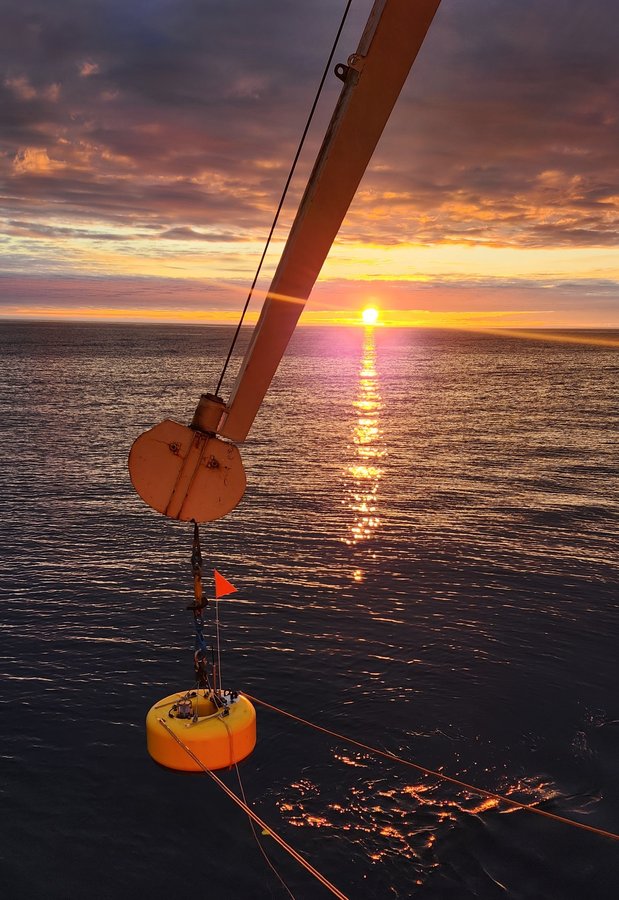
Deploying an OBS into the sunrise. Photo provided by Katie Bosman.
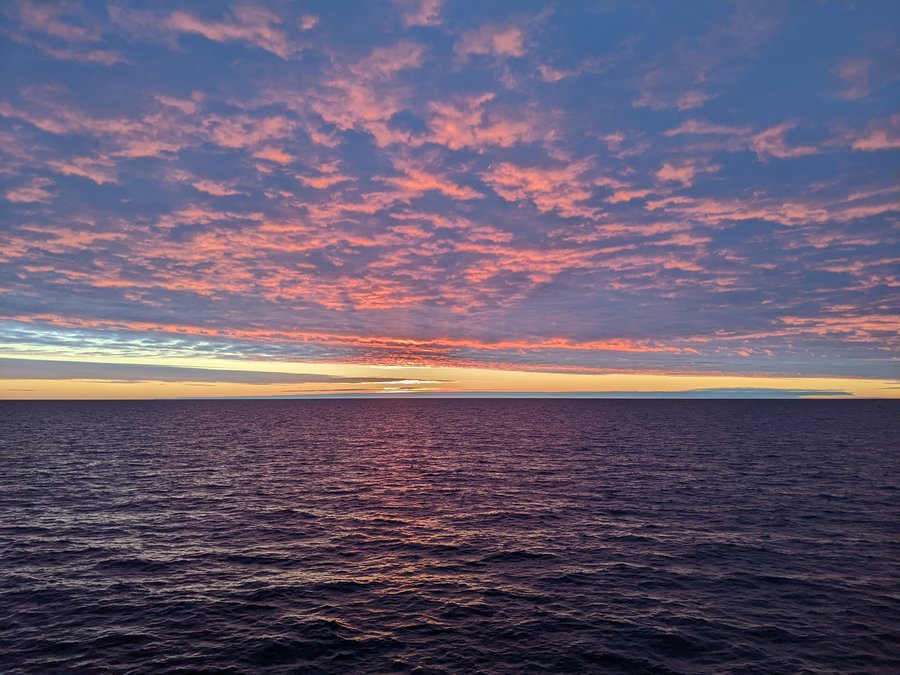
Sunset underneath cloud cover. Photo provided by Graeme Cairns.
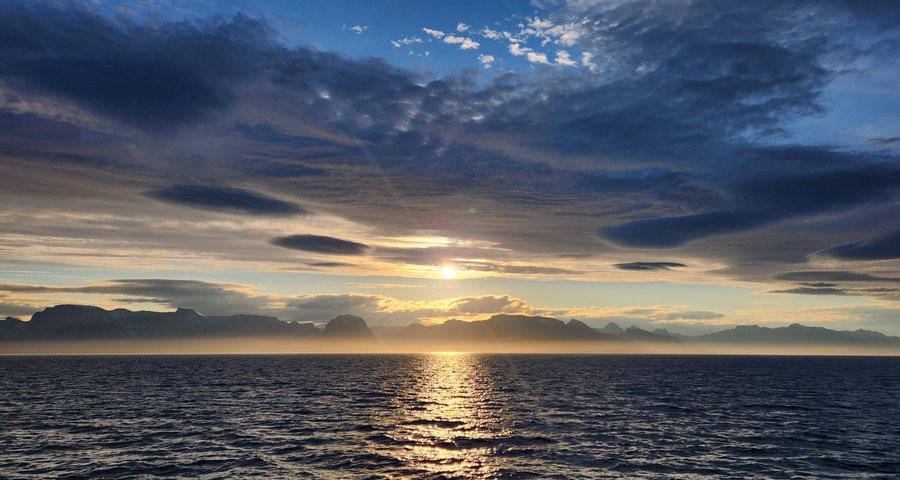
Sunset over the mountains in Frobisher Bay. Photo provided by Katie Bosman.
In other good news, while we were up north we received word that the expiry date for our CFI grant funding is extended to December 2025, giving us more time to use the remaining funds. These funds are critical to cover costs of field testing the last batches of instruments we received and modifications to address existing problems, as well as the purchase of auxiliary equipment we will use for many years to come, so the extension came as a considerable relief.
November - Seizing Opportunity
Once the dust settled from the 2024 field season, we had 9 functional OBS left in the lab (as well as several in need of repairs). Rather than leave this equipment idle, we decided to use it for a small deployment. Researchers on the Lower St. Lawrence Seaway project had enough vessel funding left for a second deployment, which meshed well with the number of available instruments and timeline to get things in the water before winter.
Due to weather and logistical challenges, it was decided to re-occupy most of the same OBS sites from the 2023-24 "Year 1" array. Site LSL01 at the west end was dropped in favour of a location filling in between LSL02 and LSL05. Using the same harbours in Matane and Petite-Tourelle from the previous deployment and recovery cruises simplified the planning process as we were already familiar with the port infrastructure available.
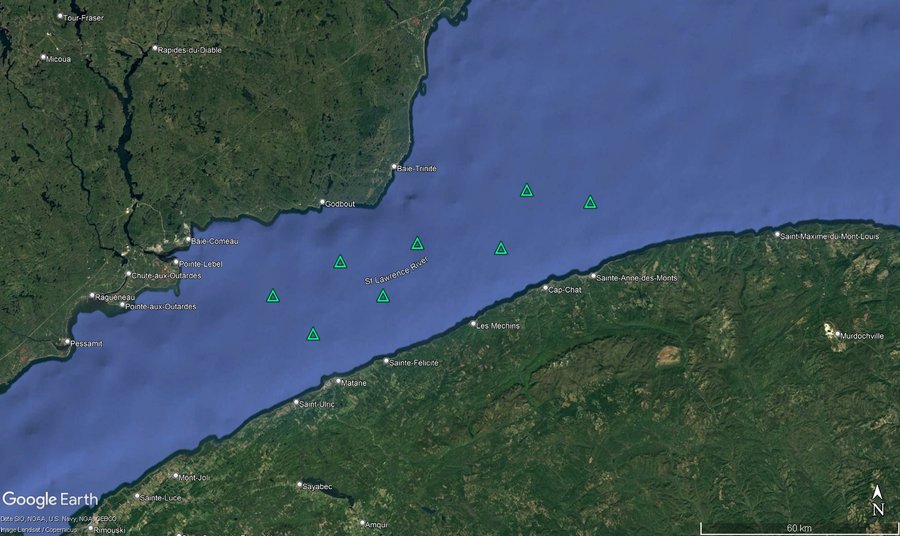
Stations deployed for Year 2 of the Lower St Lawrence Seaway monitoring project. Most stations reoccupy sites used in the Year 1 array.
The original plan was to use the Island Venture 1, as we did for the recovery in May. Unfortunately, due to weather they were unable to make the transit across the Gulf of St. Lawrence. Captain Darrin Baker reached out through a friend in the fishing community to sub-contract the R.M. Bourlingueur, owned and operated by Emmanuel (Manu) Miville, out of its home port in Sainte-Anne-des-Monts, QC. Working with a local captain, we learned a great deal about the area and its peculiarities, including weather insights and evidence of past trawling activity near one of the OBS sites. Due to the size of the boat and a few other factors, we again opted to spend nights on shore in a hotel in Matane.
Our first day out of port was cold and rainy. There were 8 people on board, so it was a bit cramped to have everyone inside the cabin at once to warm up and dry off between stations, but camaraderie prevailed. After a problem with acoustic communication on the first deployment attempt, we managed to get three OBS in the water with seafloor locations surveyed before we were forced to head into port to repair an issue with the boat's plumbing.
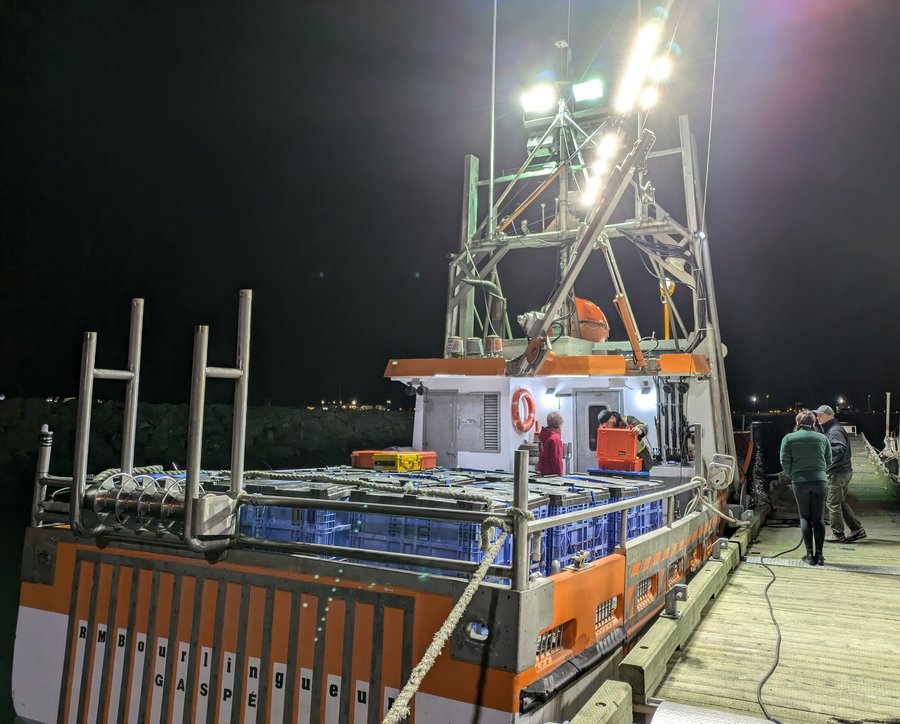
Setting up auxiliary equipment on the deck of the R.M. Bourlingueur. Photo provided by Alex Plourde.
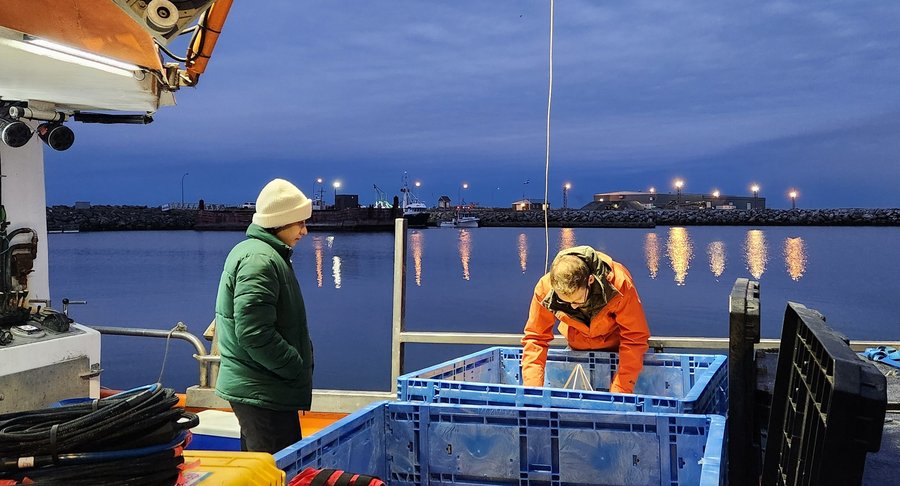
Researchers Elahe and Alex inspecting an OBS before deployment. Photo provided by Katie Bosman.
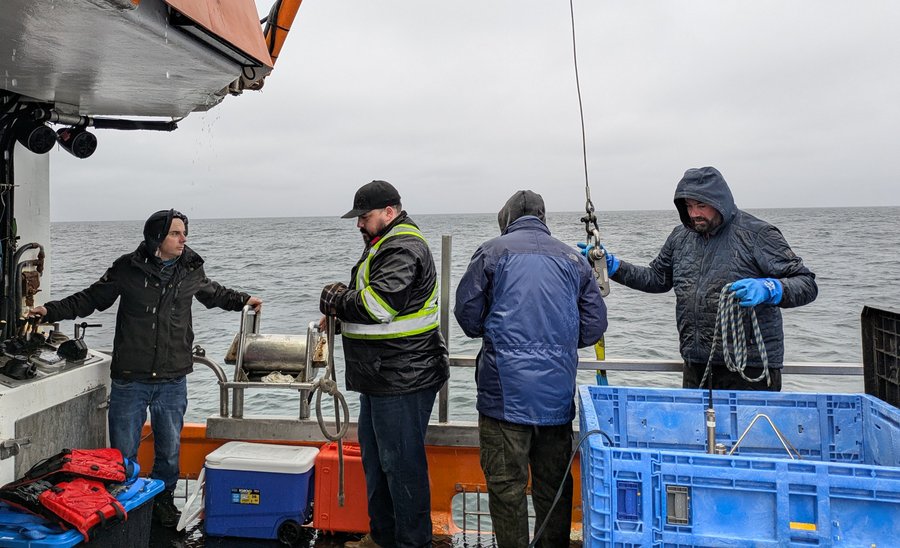
NFSI staff John and Graeme (center), with Captain Manu (left) and mate John (right) preparing to deploy an OBS in the rain. Photo provided by Alex Plourde.
On the second day of our trip, wind and sea conditions were too rough for operations as a storm blew through the area. Graeme and Chief Scientist Alex Plourde took the opportunity to drive out to Gaspé to pick up the instrument from the Year 1 array which had surfaced in the spring and drifted off. On the way, they passed through the storm which was keeping us docked, with near whiteout conditions on the main road along the coast. Picking up the instrument, which had been stored at a local welding shop, went smoothly. There was significant damage to the parts which extended above the top of the buoyancy unit. The recovery beacons were missing and the lifting frame and other metal parts were mangled, either from a ship strike or pounding against the shoreline. The underside of the pressure case was much less damaged than we expected from being washed up on the rocks where it was found. After we returned to Halifax, investigation showed evidence of water ingress about 6 weeks after the instrument was deployed. The instrument remained functional at the seabed, but experienced an electrical short which drained the batteries to their backup release threshold. We recovered about 3.5 months of usable data from the instrument, bringing total data recovery for the LSLS Year 1 array to 84%.
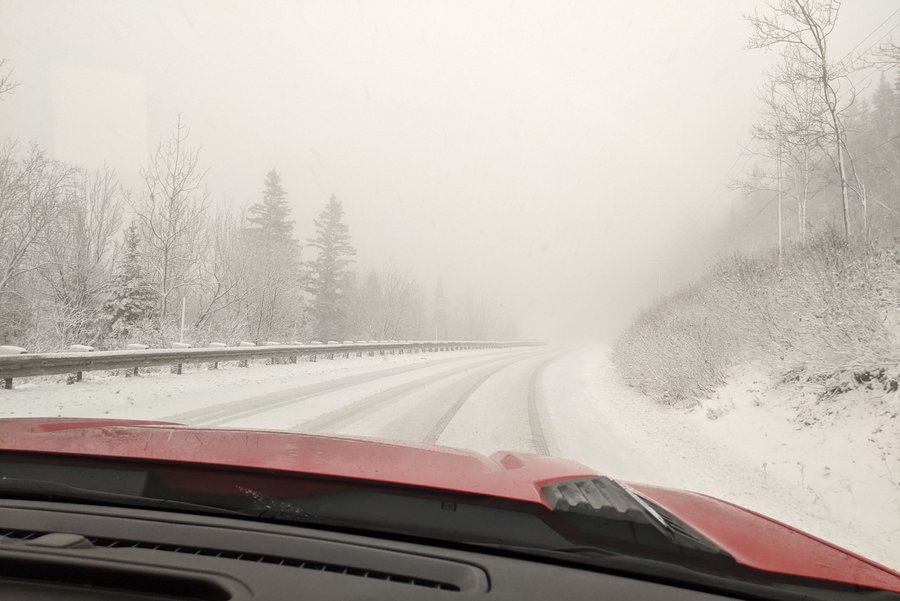
Driving from Matane to Gaspé through a blizzard. Photo provided by Graeme Cairns.
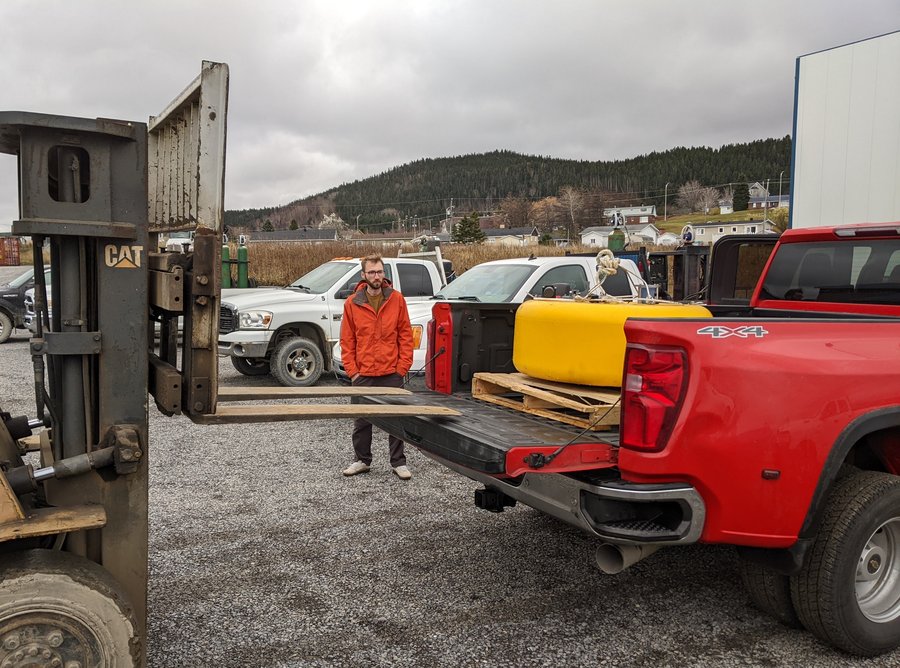
Picking up the LSL02 drifter (AQU-4D5C) from the Atelier du Soudure Gilles Aspirault in Gaspé. Photo provided by Graeme Cairns.
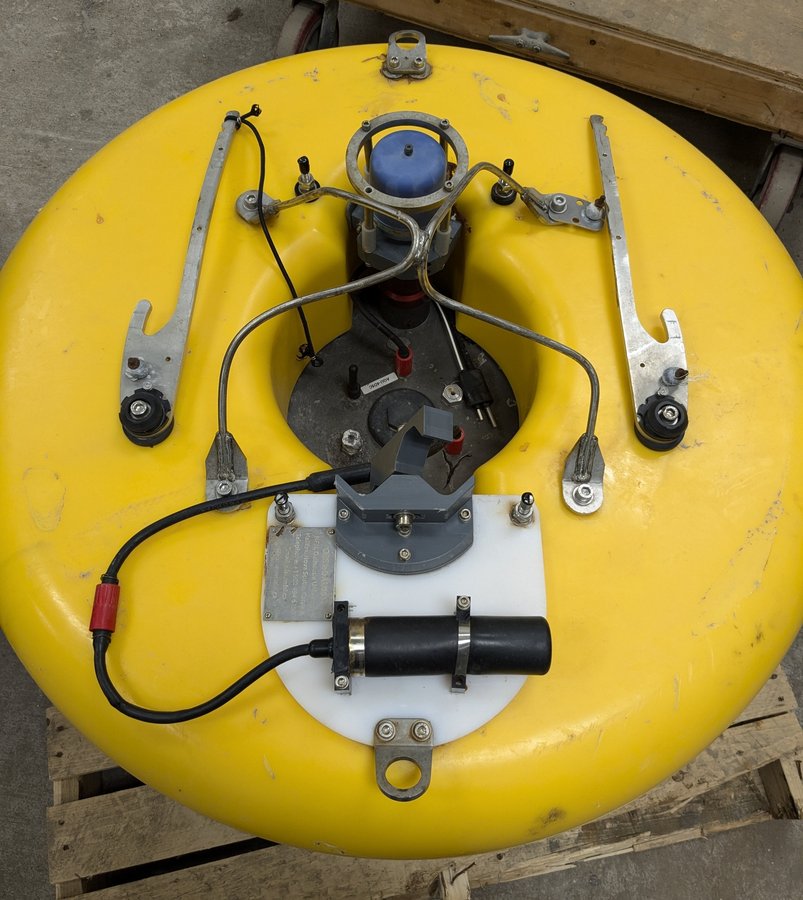
Extensive mechanical damage to parts on top of AQU-4D5C buoyancy. Photo provided by John Thibodeau.
Weather projections the next day showed calming conditions, so we set sail in the early morning although we struggled to pull out of the harbour with the wind pushing the boat against the dock, and if felt like being on a roller-coaster for the first few hours of transit. It was cold and windy most of the day, improving through the afternoon. We deployed three more instruments before needing to head in to port for some rest and more plumbing repairs. Sunset in mid-November is shortly after 4pm local time, so we were working well after dark for the final site of the day.
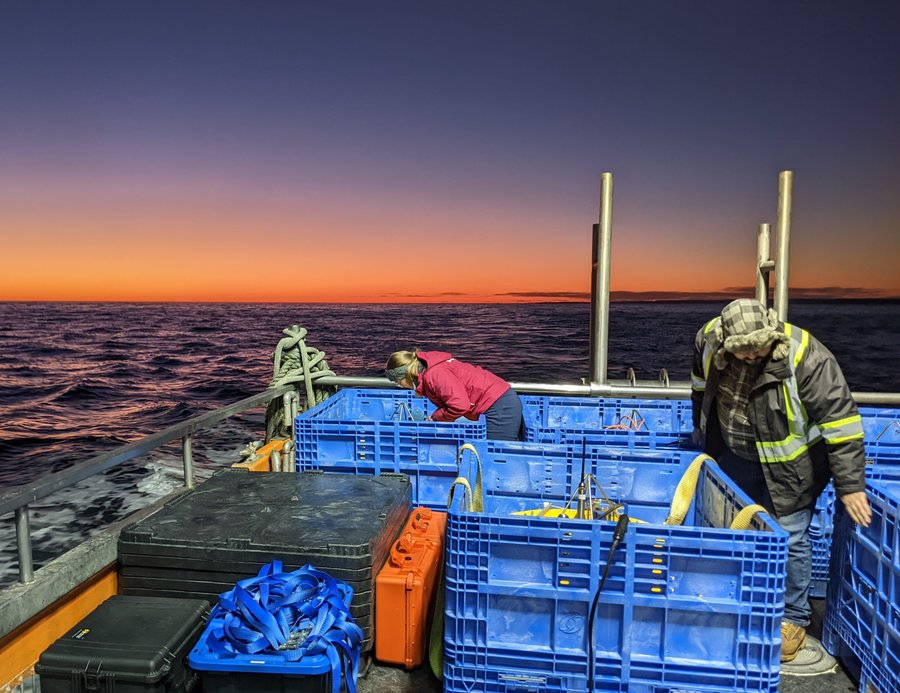
Performing pre-deployment checks on an OBS at dusk. Photo provided by Graeme Cairns.
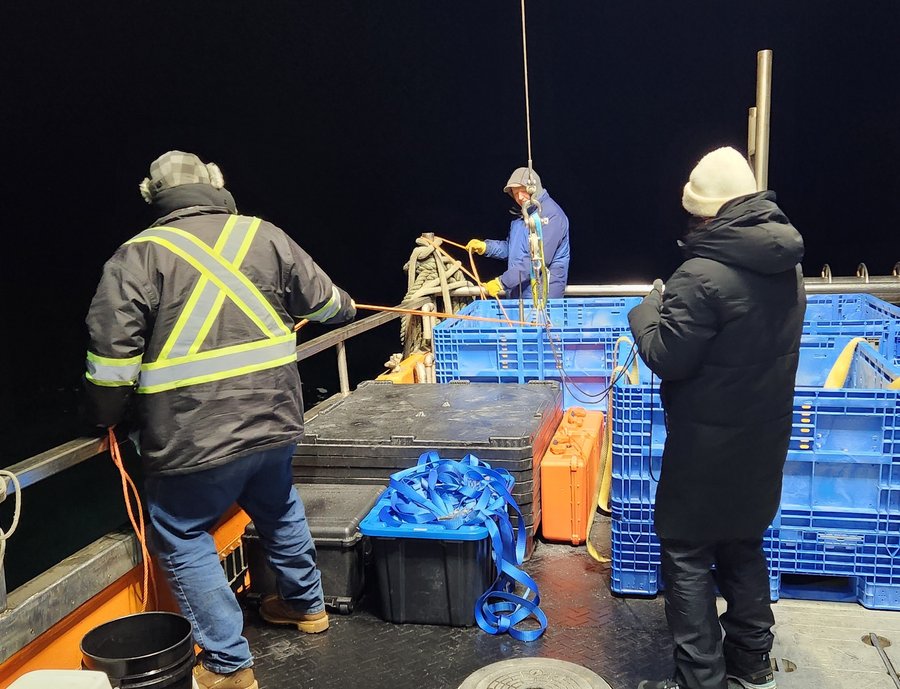
Lifting an OBS out of its storage box for deployment. Photo provided by Katie Bosman.
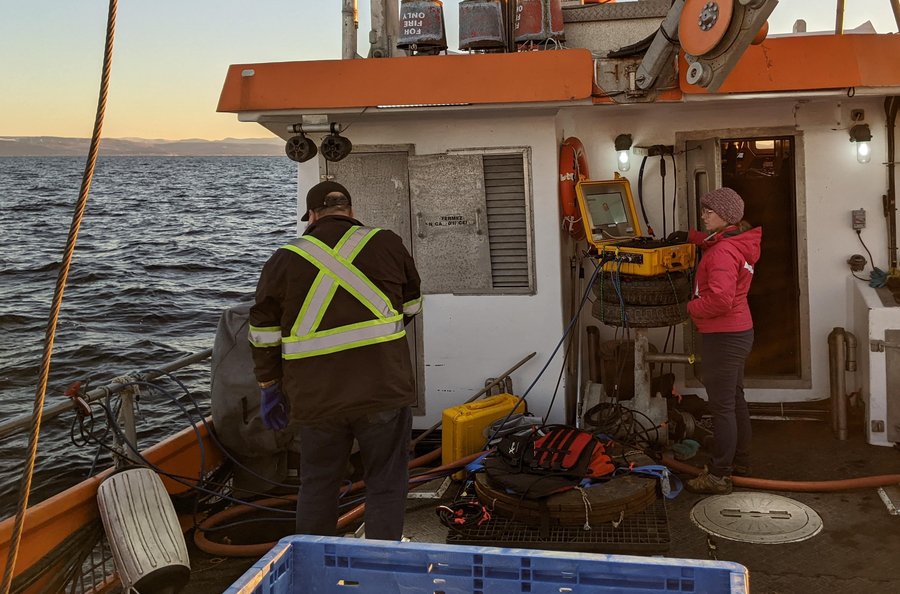
John and Katie performing an acoustic location survey for a seafloor instrument with the dunker hung over the ship's rail. Photo provided by Graeme Cairns.
Our final day on the boat we deployed two more OBS, for a total of 8 in the array. The ninth instrument had to be returned to Halifax for repairs due to a problem with acoustic communication. We finished operations just before sunset, and had enough time to tidy up and pack most of our equipment before it got dark during the transit back to port.
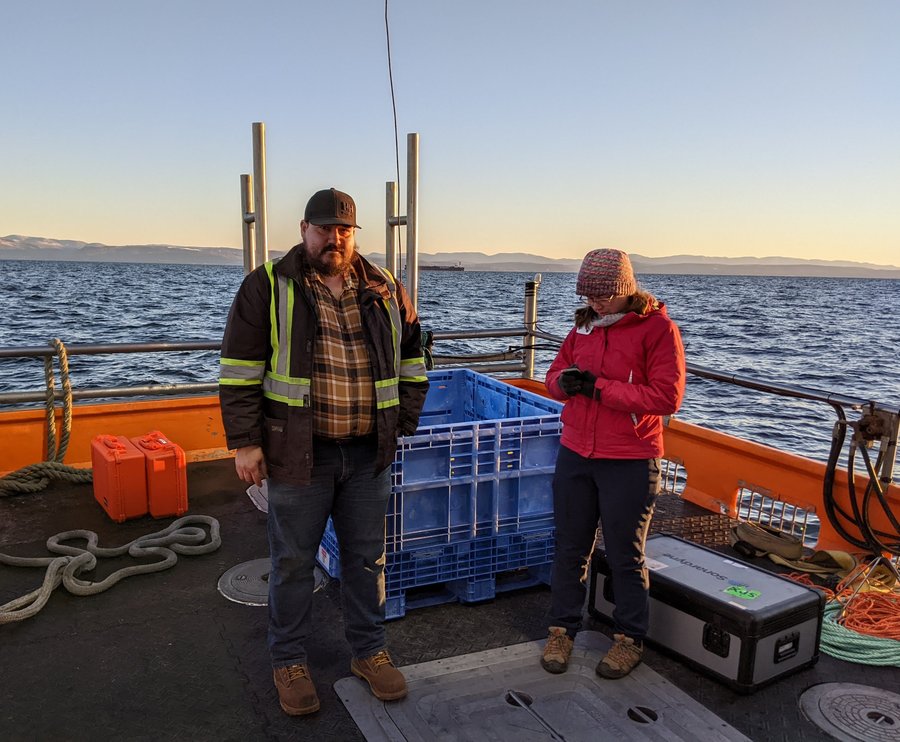
Staff were thrilled after deploying the final OBS. Photo provided by Graeme Cairns.

The moon over calm water during our final transit to Petite-Tourelle. Photo provided by John Thibodeau.
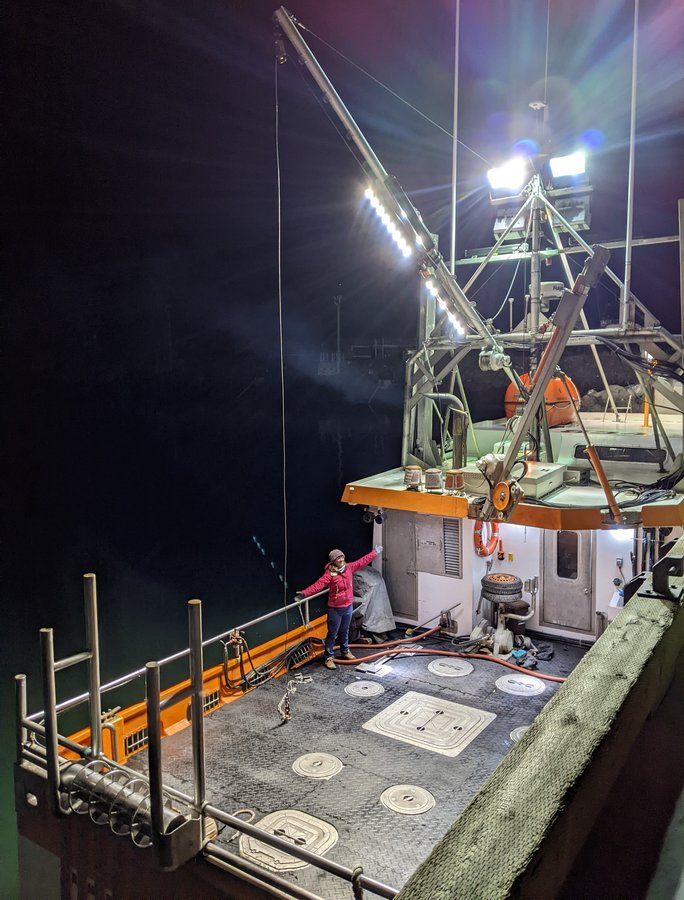
Deck of R. M. Bourlingueur empty after offloading all of our equipment. Photo provided by Graeme Cairns.
November & December - Preparing for the New Year
We spent much of late November and December preparing for a recovery operation in New Zealand scheduled for the first week in January 2025. A pallet of auxiliary equipment for the cruise was air-freighted in December, arriving in Wellington about a week before Christmas so our partners at GNS could arrange electrical testing and ensure everything was in good working order before their holiday shutdown period.
Once the shipment to New Zealand was on the way, we were able to do some forensic investigation for several instruments which surfaced unexpectedly over the past few months. In October, Güralp engineers had identified a possible water ingress path through the wires of some of the electrical connectors on the top of the pressure case. In one session, we opened and inspected 4 Aquarius instruments, which all showed evidence of water ingress consistent with this failure mechanism. Güralp is following up with the connector manufacturer on this issue.
2024 was a very busy year for us at the NFSI. By the end of the year, every functional instrument we have was deployed, except for 2 that are in storage in BC. This was a big step in building the facility up to its full capacity and proving our operational procedures in real-world conditions. We continue to learn something new with every project, and look forward to even more achievements in the years to come.